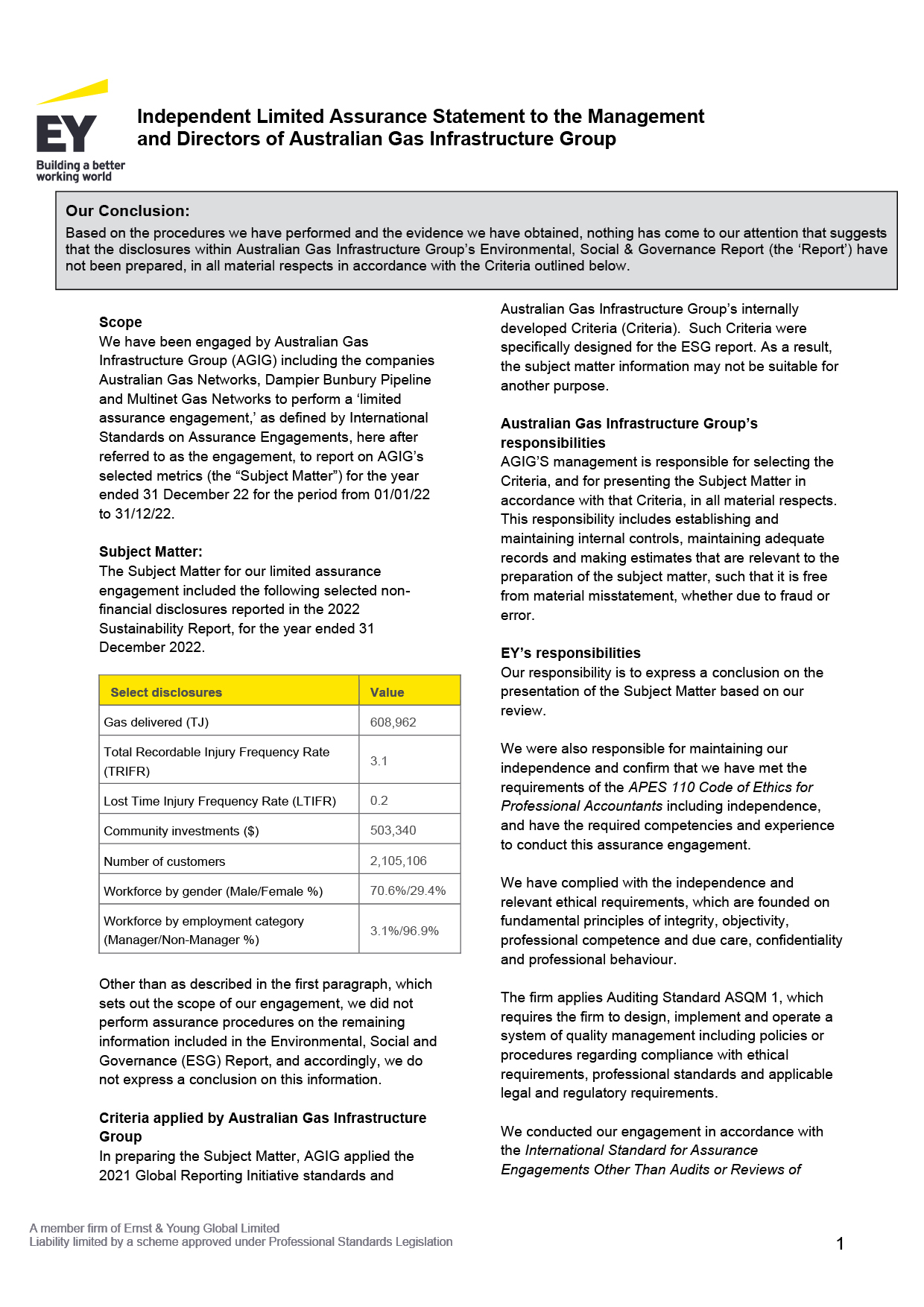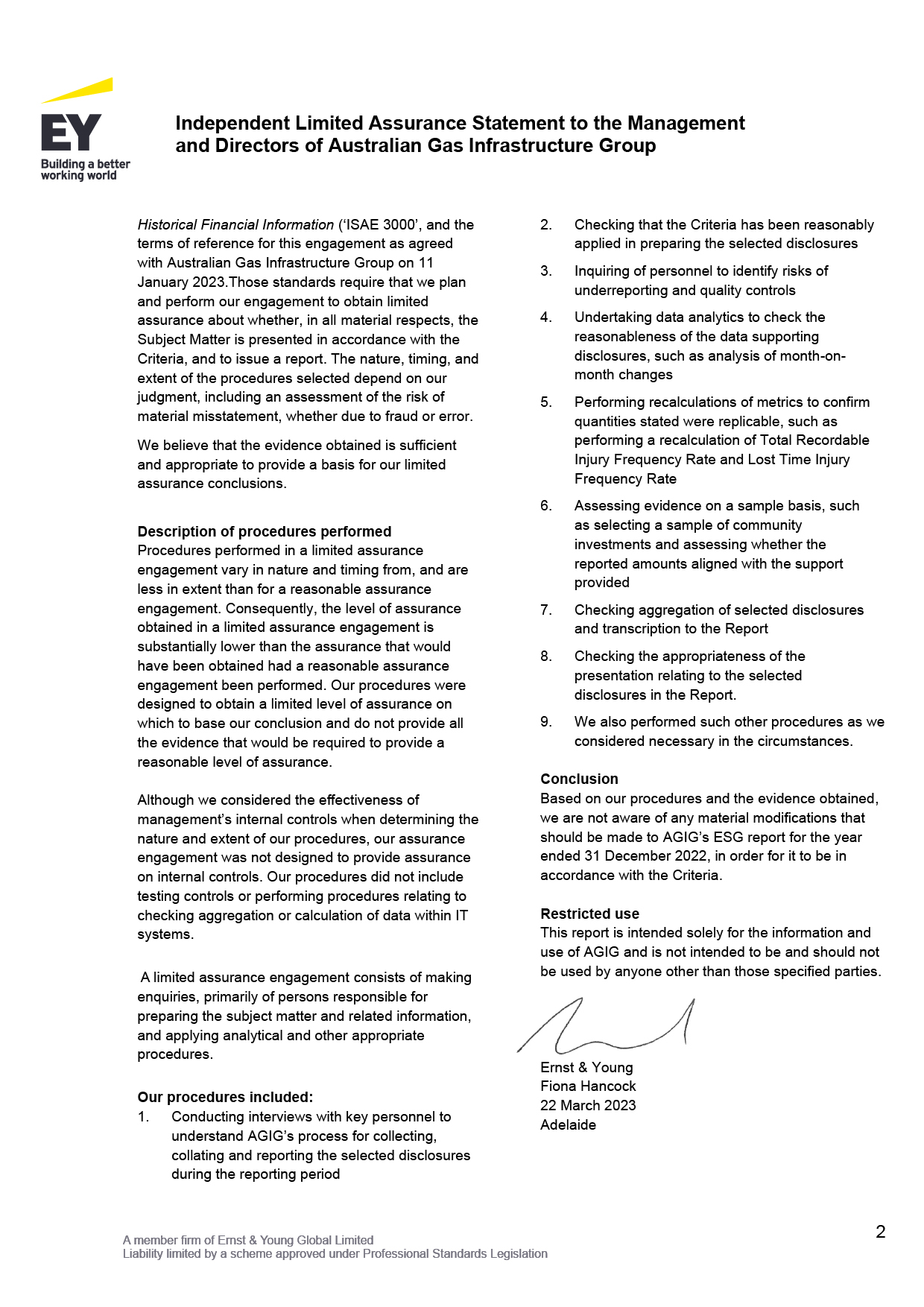Appendices
This performance data reflects the annual disclosure of our sustainability performance at operations and joint ventures where Australian Gas Infrastructure Group is the majority owner and operator. Development projects have not been included within the data disclosed unless clearly specified. Any restatements of this data set will be noted in italics with an explanation for the restatement.
About the data: figures, rounding, and intensity based denominators
Currencies: All financial figures are quoted in AUD dollars unless otherwise noted.
Rounding: Some figures and percentages may not add up to the total figure or 100 percent due to rounding.
We welcome feedback on this data set, our annual ESG report or any other aspect of our ESG performance.
Download 2023 ESG Report | Download 2023 ESG Data Table
Operational Data
Gas Delivered (TJ)
| 2023 | 2022 | 2021 | 2020 | 2019 | ||||||
|---|---|---|---|---|---|---|---|---|---|---|
| < 10 TJ | Total | < 10 TJ | Total | < 10 TJ | Total | < 10 TJ | Total | < 10 TJ | Total | |
| DBP: | - | 470,860 | - | 456,117 | - | 375,507 | - | 380,122 | - | 373,379 |
| WA* | - | 468,227 | - | 453,622 | - | 375,507 | - | 380,122 | - | 373,379 |
| NT* | - | 2,633 | - | 2,495 | - | - | - | - | - | - |
| AGN: | 50,386 | 91,581 | 55,980 | 98,287 | 56,832 | 100,245 | 56,403 | 100,413 | 54,757 | 100,823 |
| VIC | 34,722 | 50,619 | 39,097 | 55,641 | 39,990 | 56,951 | 40,032 | 56,709 | 38,573 | 55,975 |
| SA | 10,456 | 28,731 | 11,165 | 30,195 | 11,282 | 31,219 | 10,999 | 31,334 | 10,715 | 30,615 |
| QLD | 2,614 | 5,983 | 2,734 | 6,011 | 2,575 | 5,672 | 2,485 | 5,602 | 2,611 | 5,968 |
| NSW | 2,542 | 5,079 | 2,920 | 5,634 | 2,925 | 5,475 | 2,833 | 5,430 | 2,792 | 6,640 |
| NT | 52 | 1,169 | 64 | 806 | 60 | 928 | 54 | 1,338 | 66 | 1,625 |
| MGN: | 38,000 | 48,503 | 43,682 | 54,558 | 45,089 | 56,123 | 43,772 | 54,577 | 44,555 | 56,100 |
| VIC | 38,000 | 48,503 | 43,682 | 54,558 | 45,089 | 56,123 | 43,772 | 54,577 | 44,555 | 56,100 |
| Total | 88,386 | 610,944 | 99,662 | 608,962 | 101,921 | 531,875 | 100,175 | 535,112 | 99,312 | 530,302 |
*Before 2021, this row shows aggregate for WA and NT.
The WA gas delivered metric includes the DBNGP and the Pluto North-West
Interconnector
Gas Storage (PJ)
| 2023 | 2022 | 2021 | 2020 | 2019 | |
|---|---|---|---|---|---|
| WA | 60 | 60 | 60 | 60 | 57 |
Reservoir Physical Capacity.
Gas Produced (TJ)
| 2023 | |
|---|---|
| WA | 2,519 |
Native gas production - only relevant for 2023 onwards.
Renewable Gas Production (kg)
| 2023 | 2022 | 2021 | |
|---|---|---|---|
| SA (Hydrogen Park South Australia) | 15,629 | 5,001 | 406 |
Renewable hydrogen at HyP SA is produced using water and renewable electricity. Electricity is purchased from the grid and AGN purchases GreenPower Large Scale Generation Certificates which are surrendered as required to ensure that the electricity used is renewable. Production data does not include hydrogen produced during commissioning activities in 2021.
Customer Numbers
| 2023 | 2022 | 2021 | 2020 | 2019 | |
|---|---|---|---|---|---|
| DBP: | 59 | 55 | 51 | 37 | 37 |
| WA & NT | 59 | 55 | 51 | 37 | 37 |
| AGN: | 1,399,138 | 1,385,261 | 1,366,809 | 1,345,604 | 1,322,598 |
| VIC | 743,261 | 736,349 | 725,260 | 712,063 | 697,609 |
| SA | 480,223 | 474,627 | 469,451 | 463,983 | 458,020 |
| QLD | 111,375 | 110,128 | 108,966 | 107,517 | 105,878 |
| NSW | 63,109 | 62,991 | 61,968 | 60,885 | 59,942 |
| NT | 1,170 | 1,166 | 1,164 | 1,156 | 1,149 |
| MGN: | 722,843 | 719,790 | 719,436 | 717,604 | 711,484 |
| VIC | 722,843 | 719,790 | 719,436 | 717,604 | 711,484 |
| Total | 2,122,040 | 2,105,106 | 2,086,296 | 2,063,245 | 2,034,119 |
Operational Data
Asset Length (km)
| WA | VIC | SA | QLD | NSW | NT | Total | |||||||||||||||
|---|---|---|---|---|---|---|---|---|---|---|---|---|---|---|---|---|---|---|---|---|---|
| 2023 | 2022 | 2021 | 2023 | 2022 | 2021 | 2023 | 2022 | 2021 | 2023 | 2022 | 2021 | 2023 | 2022 | 2021 | 2023 | 2022 | 2021 | 2023 | 2022 | 2021 | |
| Replacement mains | N/A | N/A | N/A | 141 | 156 | 194 | 156 | 171 | 182 | 9 | 5 | 17 | 11 | 11 | 10 | N/A | N/A | N/A | 317 | 343 | 403 |
| Total Mains** | N/A | N/A | N/A | 21,951 | 21,773 | 21,664 | 8,432 | 8,349 | 8,295 | 3,307 | 3,235 | 3,194 | 2,055 | 2,035 | 2,019 | 40 | 39 | 39 | 35,785 | 35,431 | 35,211 |
| Transmission pipelines | 2,337* | 2,337 | 2,337 | 501 | 501 | 501 | 479 | 479 | 479 | 314 | 314 | 314 | 84 | 84 | 84 | 601 | 601 | 601 | 4,316 | 4,316 | 4,3166 |
**As our reporting is maturing we have noted a discrepancy in our historical distribution pipeline length. The historic data in this table has been updated from previous reports to account for this discrepancy.
*Unlooped pipe length, loop is approximately 1,524kms. Pipeline length reporting under National Greenhouse and Energy Reporting (NGERs) is 3,121kms which includes the mainline, loops and lateral lines.
Reliability
| 2023 | 2022 | 2021 | |||||||
|---|---|---|---|---|---|---|---|---|---|
| AGN | MGN | DBP | AGN | MGN | DBP | AGN | MGN | DBP | |
| Number of unplanned interruptions affecting 5+ customers | 37 | 33 | N/A | 33 | 45 | N/A | 26 | 34 | N/A |
| Number of customers having 3+ interruptions within 12 months* | 10 | 135 | N/A | 10 | 233 | N/A | 19 | 165 | N/A |
| DBNGP system reliability | N/A | N/A | 100.0% | N/A | N/A | 100.0% | N/A | N/A | 100.0% |
| DBNGP compressor station reliability | N/A | N/A | 94.6% | N/A | N/A | 95.5% | N/A | N/A | 99.4% |
Environmental Data
National Greenhouse and Energy Reporting (NGER) Scheme
Greenhouse Gas Emissions (GHG) (tonnes of carbon dioxide equivalent, t CO2-e)
| 2023 | 2022 | 2021 | |
|---|---|---|---|
| GHG – Scope 1 | 776,557 | 757,887 | 839,666 |
| GHG – Scope 2 | 3,238 | 3,801 | 3,756 |
| GHG – Total | 779,795 | 761,688 | 843,422 |
| 2023 | 2022 | 2021 | |||||||
|---|---|---|---|---|---|---|---|---|---|
| AGN | DBP | MGN | AGN | DBP | MGN | AGN | DBP | MGN | |
| GHG - Scope 1 | 326,995 | 267,179 | 182,383 | 328,080 | 225,094 | 204,713 | 381,173 | 243,269 | 215,224 |
| GHG - Scope 2 | 370 | 1,258 | 1,610 | 601 | 1,519 | 1,681 | 724 | 1,191 | 1,841 |
| GHG - Total | 327,365 | 268,437 | 183,993 | 328,681 | 226,613 | 206,394 | 381,897 | 244,460 | 217,065 |
Greenhouse gas data is reported in line with the NGER scheme. NGER Technical Guidelines have been developed by the Australian Government Department of the Environment and Energy, based on Australian Financial Year reporting. Data is reported for the AGIG facilities captured NGER.
Note: there are minor sources of emission not currently captured in the AGN, MGN or DBP facilities. These are being assessed for future reporting, indicatively approximately 24,000 tCO2e in total in 2023.
Waste Produced by Type (tonnes)
| 2023 | 2022 | 2021 | |
|---|---|---|---|
| Hazardous waste | 1,065 | 1,122 | 1,063 |
| Non-hazardous waste | 405 | 470 | 441 |
| Total Waste | 1,470 | 1,592 | 1,504 |
Waste data is not collected at all AGIG sites. This data represents DBP sites, AGN office and MGN office only. AGIG has a waste target to collect and report by the end 2024.
Recycling (tonnes)
| 2023 | 2022 | 2021 | |
|---|---|---|---|
| Recycling | 17 | 59 | 17 |
Governance Data
Governance
| 2023 | 2022 | 2021 | ||||||||||
|---|---|---|---|---|---|---|---|---|---|---|---|---|
| AGN | DBP | MGN | TOTAL | AGN | DBP | MGN | TOTAL | AGN | DBP | MGN | TOTAL | |
| Confirmed incidents of corruption and actions taken | 0 | 0 | 0 | 0 | 0 | 0 | 0 | 0 | 0 | 0 | 0 | 0 |
| Percentage of employees that received training on anti-corruption/ethics and integrity* | 32.0% | 24.6% | 24.1% | 26.4% | 1.4% | 7.0% | 1.7% | 10.0% | 1.0% | 21.7% | 14.5% | 37.0% |
| Whistle-blower reports | 0 | 0 | 0 | 0 | 0 | 1 | 0 | 1 | 0 | 0 | 0 | 0 |
| Whilstle-blower reports involving bribery/corruption | 0 | 0 | 0 | 0 | 0 | 1 | 0 | 1 | 0 | 0 | 0 | 0 |
*AGIG’s anti-corruption training is mandatory upon commencement, and is required to be refreshed every two years (this was updated in 2023, previously refreshed training was required every three years).
Legal cases relating to corruption can be found at Communities and Human Rights , page 09.
Cyber Security
| 2023 | 2022 | 2021 | ||||||||||
|---|---|---|---|---|---|---|---|---|---|---|---|---|
| AGN | DBP | MGN | TOTAL | AGN | DBP | MGN | TOTAL | AGN | DBP | MGN | TOTAL | |
| Significant notifiable cyber security breaches | 0 | 0 | 0 | 0 | 0 | 0 | 0 | 0 | 0 | 0 | 0 | 0 |
Modern Slavery
| 2023 | ||||
|---|---|---|---|---|
| AGN | DBP | MGN | Total | |
| Total training hours for Modern Slavery | 15 | 34 | 8 | 57 |
| Number of Suppliers completed Modern Slavery Risk Assessment | 40 | |||
This is a new metric for 2023 reporting, historic data is not available.
Employment Data
Workforce by Employment Type
| 2023 | 2022 | 2021 | |||||||
|---|---|---|---|---|---|---|---|---|---|
| AGN | DBP | MGN | AGN | DBP | MGN | AGN | DBP | MGN | |
| Full-time employees | 93.0% | 91.9% | 93.7% | 96.8% | 92.8% | 91.5% | 97.1% | 92.1% | 92.1% |
| Part-time employees | 5.2% | 7.0% | 6.3% | 3.2% | 7.2% | 8.5% | 2.9% | 7.9% | 7.9% |
| Casual employees | 1.8% | 1.1% | 0.0% | - | - | - | - | - | - |
| Total number | 114 | 285 | 79 | 93 | 251 | 71 | 69 | 240 | 76 |
Casual employees is a new metric for 2023 reporting and historical data is not available.
Workforce by Gender
| 2023 | 2022* | 2021* | |||||||
|---|---|---|---|---|---|---|---|---|---|
| AGN | DBP | MGN | AGN | DBP | MGN | AGN | DBP | MGN | |
| Male | 54.4% | 72.3% | 59.5% | 55.6% | 79.0% | 61.5% | 55.2% | 79.6% | 65.7% |
| Female | 45.6% | 27.7% | 40.5% | 44.4% | 21.0% | 38.5% | 44.8% | 20.4% | 34.3% |
| Undisclosed | 0.0% | 0.0% | 0.0% | 0.0% | 0.0% | 0.0% | 0.0% | 0.0% | 0.0% |
| Total number | 114 | 285 | 79 | 90 | 233 | 65 | 67 | 221 | 70 |
2023 data includes full-time, part-time and casual employees. Historic data only includes full-time employees.
Workforce by Employment Category
| 2023 | 2022 | 2021 | |||||||
|---|---|---|---|---|---|---|---|---|---|
| AGN | DBP | MGN | AGN | DBP | MGN | AGN | DBP | MGN | |
| Managers* | 7.0% | 1.1% | 1.4% | 8.9% | 1.3% | 1.5% | 17.9% | 10.0% | 14.3% |
| Non-managers | 93.0% | 98.9% | 98.6% | 91.1% | 98.7% | 98.5% | 82.1% | 90.0% | 85.7% |
| Total number | 114 | 285 | 79 | 90 | 233 | 65 | 67 | 221 | 70 |
*The decrease in 2022 Managers compared to 2021 relates to a re-classification in 2022 to define Managers as Executive General Managers and Directors only
Workforce by Region
| 2023 | |||
|---|---|---|---|
| AGN | DBP | MGN | |
| Adelaide | 55 | 3 | - |
| Brisbane | 5 | 1 | - |
| Canberra | 1 | 1 | 1 |
| Melbourne | 45 | 2 | 77 |
| Sydney | - | 3 | - |
| Perth | 8 | 275 | 1 |
| Total number | 114 | 285 | 79 |
This is a new metric for 2023 reporting, historic data is not available.
Employment Data
Full-Time Workforce by Age Group
| 2023 | 2022 | 2021 | |||||||
|---|---|---|---|---|---|---|---|---|---|
| AGN | DBP | MGN | AGN | DBP | MGN | AGN | DBP | MGN | |
| < 19 | 0.0% | 0.0% | 0.0% | 0.0% | 0.0% | 0.0% | 0.0% | 0.4% | 0.0% |
| 20-29 | 6.6% | 6.9% | 12.2% | 3.3% | 4.7% | 7.7% | 1.7% | 4.9% | 5.7% |
| 30-39 | 22.6% | 24.0% | 27.0% | 21.1% | 25.3% | 24.6% | 15.3% | 23.1% | 25.7% |
| 40-49 | 31.2% | 33.2% | 17.6% | 27.8% | 27.5% | 20.0% | 39.0% | 34.0% | 20.0% |
| 50-59 | 28.3% | 21.8% | 31.1% | 32.2% | 27.5% | 33.8% | 30.5% | 24.9% | 35.7% |
| > 60 | 11.3% | 14.1% | 12.2% | 15.6% | 15.0% | 13.9% | 13.5% | 12.7% | 12.9% |
| Total number | 106 | 262 | 74 | 90 | 233 | 65 | 67 | 221 | 70 |
Full-Time Workforce Turnover Rate by Gender
| 2023 | 2022 | 2021 | ||||||||||
|---|---|---|---|---|---|---|---|---|---|---|---|---|
| AGN | DBP | MGN | TOTAL | AGN | DBP | MGN | TOTAL | AGN | DBP | MGN | TOTAL | |
| Male | 12.9% | 8.5% | 12.8% | 5.2% | 8.0% | 18.5% | 35.0% | 17.9% | 21.7% | 13.1% | 4.4% | N/A |
| Female | 7.7% | 19.7% | 9.4% | 4.8% | 7.5% | 40.8% | 12.0% | 18.4% | 13.3% | 22.2% | 4.2% | N/A |
| Undisclosed | 0.0% | 0.0% | 0.0% | 0.0% | 0.0% | 0.0% | 0.0% | 0.0% | 0.0% | 0.0% | 0.0% | 0.0% |
Gender turnover data should be read with the context of some business units having a smaller headcount.
Full-Time Workforce Turnover Rate by Age Group
| 2023 | 2022 | 2021 | |||||||
|---|---|---|---|---|---|---|---|---|---|
| AGN | DBP | MGN | AGN | DBP | MGN | AGN | DBP | MGN | |
| < 19 | 0.0% | 0.0% | 0.0% | 0.0% | 100.0% | 0.0% | 0.0% | 0.0% | 0.0% |
| 20-29 | 0.0% | 11.1% | 11.1% | 0.0% | 54.5% | 80.0% | 0.0% | 45.5% | 50.0% |
| 30-39 | 12.5% | 1.6% | 30.0% | 10.5% | 23.7% | 31.3% | 7.1% | 23.5% | 0.0% |
| 40-49 | 9.1% | 16.1% | 0.0% | 4.0% | 26.6% | 15.4% | 25.0% | 6.7% | 0.0% |
| 50-59 | 20.0% | 14.0% | 4.3% | 13.8% | 15.6% | 18.2% | 13.0% | 9.1% | 4.0% |
| > 60 | 0.0% | 10.8% | 11.1% | 0.0% | 17.1% | 22.2% | 42.9% | 21.4% | 0.0% |
Workforce New Hires
| 2023 | |||
|---|---|---|---|
| AGN | DBP | MGN | |
| Male | 60.0% | 57.8% | 70.6% |
| Female | 40.0% | 42.2% | 29.4% |
| Undisclosed | 0.0% | 0.0% | 0.0% |
This is a new metric for 2023 reporting, historic data is not avaliable.
Employment Data
Trained Full-time Employees by Gender
| 2023 | 2022 | 2021 | |||||||
|---|---|---|---|---|---|---|---|---|---|
| AGN | DBP | MGN | AGN | DBP | MGN | AGN | DBP | MGN | |
| Male | 56.0% | 74.5% | 61.0% | 55.6% | 79.0% | 69.2% | 55.2% | 74.8% | 65.7% |
| Female | 44.0% | 25.5% | 39.0% | 44.4% | 21.0% | 30.8% | 44.8% | 25.2% | 34.3% |
| Undisclosed | 0.0% | 0.0% | 0.0% | - | - | - | - | - | - |
| Total number | 100.0% | 100.0% | 100.0% | 100.0% | 100.0% | 100.0% | 100.0% | 100.0% | 100.0% |
This is a new metric for 2023 reporting, historic data is not available.
Trained Employees by Employment Category
| 2023 | 2022 | 2021 | |||||||
|---|---|---|---|---|---|---|---|---|---|
| AGN | DBP | MGN | AGN | DBP | MGN | AGN | DBP | MGN | |
| Managers | 4.3% | 1.0% | 1.3% | 8.9% | 1.3% | 0.0% | 17.9% | 1.2% | 14.3% |
| Non-managers | 95.7% | 99.0% | 98.7% | 91.1% | 98.7% | 100.0% | 82.1% | 98.8% | 85.7% |
| Total number | 100.0% | 100.0% | 100.0% | 100.0% | 100.0% | 100.0% | 100.0% | 100.0% | 100.0% |
Trained employees are those employed across the reporting period.
Training Completed by Employees by Gender (hours)
| 2023 | 2022 | 2021 | |||||||
|---|---|---|---|---|---|---|---|---|---|
| AGN | DBP | MGN | AGN | DBP | MGN | AGN | DBP | MGN | |
| Male | 350 | 6,350 | 376 | 136 | 5,184 | 130 | 137 | 2,640 | 481 |
| Female | 362 | 883 | 145 | 141 | 679 | 83 | 111 | 772 | 251 |
| Undisclosed | 0 | 0 | 0 | - | - | - | - | - | - |
| Total number | 712 | 7,233 | 521 | 277 | 5,863 | 212 | 248 | 3,412 | 732 |
Training Completed by Employees by Employment Category (hours)
| 2023 | 2022 | 2021 | |||||||
|---|---|---|---|---|---|---|---|---|---|
| AGN | DBP | MGN | AGN | DBP | MGN | AGN | DBP | MGN | |
| Managers | 70 | 71 | 4 | 12 | 43 | - | 44 | 47 | 73 |
| Non-managers | 642 | 7,162 | 517 | 265 | 5,820 | 212 | 204 | 3,365 | 659 |
| Total number | 712 | 7,233 | 521 | 277 | 5,863 | 212 | 248 | 3,412 | 732 |
Safety Data
Injury Statistics
| 2023 | 2022 | 2021 | ||||||||||
|---|---|---|---|---|---|---|---|---|---|---|---|---|
| AGIG | AGN | DBP | MGN | AGIG | AGN | DBP | MGN | AGIG | ||||
| Total recordable injury frequency rate (TRIFR) | 4.3 | 2.9 | 9.9 | 5.0 | 3.1 | 2.8 | 3.8 | 3.4 | 6.7 | |||
| Lost time injury frequency rate (LTIFR) | 2.1 | 1.1 | 3.3 | 4.0 | 0.2 | 0.4 | - | - | 0.8 | |||
| Total number of fatalities as a result of work-related injury | 0 | 0 | 0 | 0 | 0 | 0 | 0 | - | 0 | |||
TRIFR - Identifies the number of Lost Time (LTI), Medically Treated (MTI) and Restricted Work Cases (RWC) standarised per 1,000,000 hours worked.
Safety Incident Statistics
| 2023 | 2022 | 2021 | |
|---|---|---|---|
| Total number of Tier 1 and Tier 2 safety incidents | 0 | 0 | 0 |
| Total number of Tier 3 and Tier 4 safety incidents % | 81.7% | 82.0% | 83.0% |
| % of public leak reports responded in 2 hours | 98.8% | 99.0% | 98.9% |
| % of Leak Management Plan (LMP) leak surveys compliance | 100% | 100% | 100% |
The AGN and MGN leak survey compliance is 100% for the reporting period across all networks.
Public Safety
| 2023 | 2022 | 2021 | ||||||||
|---|---|---|---|---|---|---|---|---|---|---|
| AGN | MGN | DBP | AGN | MGN | DBP | AGN | MGN | DBP | ||
| % of public leak reports responded to in 2 hours (1 hour MGN) | Distribution | 99.6% | 98.5% | N/A | 99.3% | 98.8% | N/A | 99.2% | 98.0% | N/A |
| LMP Class 1 and Class 2 lead repair -%performance with LMP target timeframe | Distribution | 100% | 99.5% | N/A | 99.3% | 99.1% | N/A | 99.7% | 97.0% | N/A |
Community and Human Rights
Community Partnerships Program
| 2023 | 2022 | 2021 | |
|---|---|---|---|
| Community investment ($ thousands) | 524 | 503 | 457 |
| Volunteer hours | 670 | 359 | 76 |
AGN proportion of Community Investment is $175,000 and volunteer hours is 230.5.
Community and Anti-corruption Data
| 2023 | 2022 | 2021 | |
|---|---|---|---|
| Legal cases relating to corruption practices | 0 | 0 | 0 |
AGN proportion of Legal cases relating to corruption practices is 0.
Supply Chain Data
Number of Tier 1 Suppliers by Location
| 2023 | 2022 | 2021 | |
|---|---|---|---|
| Australia | 1,635 | 1,631 | 1,464 |
| Hong Kong | 7 | 5 | 7 |
| Mainland China | 2 | 1 | - |
| Asia (excl. Hong Kong and Mainland China) | 4 | 3 | 2 |
| United Kingdom | 5 | 5 | 3 |
| Europe | 10 | 8 | 9 |
| Canada | 3 | 2 | 1 |
| United States of America | 17 | 17 | 13 |
| New Zealand | 3 | 1 | 4 |
| Other Regions | - | 2 | 3 |
| Total number | 1,686 | 1,675 | 1,506 |
Tier 1 suppliers are active suppliers during the reporting period.
AGN proportion of Tier 1 suppliers is 584, with suppliers located in - Australia (575), Hong Kong (2), Mainland China (1), Asia (excl. Hong Kong and Mainland China 1), Europe (1), United States of America (2) and New Zealand (2).
Responsible Supply Chain
| 2023 | 2022 | |
|---|---|---|
| Proportion of spending on local suppliers (percentage) | 97% | 98% |
This is a new metric for 2022 reporting, historic data for 2021 is not avaliable.
AGN proportion of spending on local suppliers is 96% for the reporting period.
Appendix 2: Global Reporting Initiatives Index
Global Reporting Initiative (GRI) Standards Index
| UNIVERSAL STANDARDS | DISCLOSURE TITLE | REFERENCE TO DISCLOSURE |
General Disclosures |
||
| 2-1 | Organisation details | |
| a) Legal name | Australian Gas Infrastructure Group (Dampier Bunbury Pipeline, Multinet Gas Networks and Australian Gas Networks (page 3) | |
| b) Nature of ownership and legal form |
About Australian Gas Infrastructure Group (pages 2-3) Our role and business (pages 6-9) AGIG Website www.agig.com.au |
|
| c) Location of headquarters | Level 6, 400 King William Street, Adelaide SA 5000 | |
| d) Countries of operations |
Our Business, (page 7) AGIG Website Entity reporting is outlined in the Data Tables, Appendices (page 10) |
|
| 2-2 | Entities included in our sustainability reporting | Australian Gas Infrastructure Group (Dampier Bunbury Pipeline, Multinet Gas Networks and Australian Gas Networks page 3 ) |
| Location of headquarters | Level 6, 400 King William Street, Adelaide SA 5000 | |
| 2-3 | Reporting details | |
| a) Reporting period and frequency | Reporting period is 1 January to 31 December 2024, refer to the Governance section | |
| b) Financial reporting period | Reporting period is 1 January to 31 December 2024, refer to the Governance section | |
| c) Publication date of report | March 2024 | |
| d) Contact point for questions | Mediaenquiries@agig.com.au | |
| 2-4 | Restatements of information | Pipeline length for 2022 and 2021 has been restated |
| 2-5 | External assurance | AGIG’s 2023 ESG report has limited assurance performed Details of the assurance performed and relationship between AGIG and the providers is outlined at (page 27) |
|
2-6 |
Actitivies and workers |
|
| a) Sectors we are active |
About AGIG (page 3)
|
|
| b) Describe AGIG’s value chain | Sustainable Procurement Statement (www.agig.com.au/publications) | |
| c) Report other relevant business relationships | AGIG is the Manager of the Fortescue River Gas Pipeline Joint Venture with TEC Pilbara Pty Ltd | |
| d) Describe changes (to above) since last reporting period | Pipeline length for 2022 and 2021 has been restated | |
|
2-7 |
Employees |
|
| a) Total number of employees (by gender and region) | Data Tables, Employment Data Appendices (pages 5-7) | |
| b) Number of employees by, permanent, temporary, non-guaranteed hours/ casual, full-time employees and part-time employees | Data Tables, Employment Data Appendices (pages 5) | |
| c) Methodology and assumptions used to compile the data | All employee types as at 31st December 2023 is outlined in our Appendices
on (page 5) Total number of employees as at 31 December 2023 |
|
| d) Report contextual information to understand data at a and b | Data provided is based on all employees as at 31st December 2023 | |
| e) Describe significant fluctuations in the number of employees during the reporting period and between reporting periods | There are no significant fluctations in the number of employees during the reporting period or between reporting periods Metric being considered for future disclosures |
|
| 2-8 | Workers who are not employees | Australian Gas Infrastructure Group (Dampier Bunbury Pipeline, Multinet Gas Networks and Australian Gas Networks s (page 2) |
Governance |
||
| 2-9 | Governance structure and composition | |
| a) Describe AGIG’s governance structure, including committees of the highest governance body | Refer to the Governance section (pages 14-18) | |
| b) List the committees of the highest governance today | Refer to the Governance section (pages 14-18) | |
| c) Describe the composition of the highest governance body and it’s committees by: | Refer to the Governance section (pages 14-18) | |
| i. executive and non-executive members | Metric being considered for future disclosure | |
| ii. independence | ||
| iii. tenure of members on the governance body | ||
| iv. number of other significant positions and committments held by each member, and the nature of the commitments; | ||
| v. gender; | ||
| vi. under-represented social groups | ||
| vii. competencies relevant to the impacts of the organisation; | ||
| viii. stakeholder representation | ||
| 2-10 | Nomination and selection of the highest governance body | Metric being considered for future disclosure |
| 2-11 | Chair of the highest governance body | Message from Chairs (pages 12-13) |
| 2-12 | Role of the highest governance body in overseeing the management of impacts | AGIG’s ESG Committees assists the Boards in fulfilling oversight responsbilities and duties relating to developing, approving and updating the purpose, strategy and policy goals in relation to sustainability. For sub-disclosures, refer to the Governance infographic on (page 14) |
| 2-13 | Delegation of responsiblity for managing impacts | Risk and Compliance Committee, refer to Governance Section (page 14) |
| 2-14 | Role of the highest governance body in sustainability reporting | ESG Committee, refer to Governance Section (page 14) |
| 2-15 | Conflicts of interest | Metric being considered for future disclosure |
| 2-16 | Communication of critical concerns | |
| 2-17 | Collective knowledge of the highest governance body | |
| 2-18 | Evalulation of the performance of the highest governance body | |
| 2-19 | Remuneration policies | |
| 2-20 | Process to determine remuneration | |
| 2-21 | Annual total compensation ratio | |
Strategy, Policies and Practices |
||
| 2-29 | Compliance with laws and regulations | AGIG commits to abiding by all applicable laws and regulations in the places we conduct our activities and operations. ESG Principles we subscribe to include those outlined in the vision, goals and principles of the UN Sustainable Development Goals, and the associations we are a member of, as listed in GRI 102-13. We also have a number of external legislative, regulatory and voluntary ESG frameworks we adhere to, as described on our website. AGIG has no significant instances of noncompliance with laws and regulations to report during this period |
| 2-30 | Collective bargaining agreements | Australian Hydrogen Council, Australian Pipelines and Gas Association, Bioenergy Australia, Clean Energy Council, Energy Networks Association (ENA), Energy Charter, Future Fuels Cooperative Research Centre |
Stakeholder Engagement |
||
| 2-29 | Approach to stakeholder engagement | AGIG’s Stakeholder engagement can be found on our website www.agig.com.au |
| 2-30 | Collective bargaining agreements | AGIG requires that employees’ and contractor remuneration complies with statutory and regulatory requirements, and does not have any employees whose compensation is subject to Collective bargaining agreements |
Material Topics |
||
| 3-1 | Process to determine material topics | Risk and Compliance Committee, refer to Governance Section (pages 14-15) |
| 3-2 | List of material topics | Metric being consider for future disclosure |
| 3-3 | Management of material topics | Metric being consider for future disclosure |
Industry Specific Standards GRI 11: Oil and Gas Sector 2021 Material Topics
| 11-1 | GHG emissions | |
| 11-1-1 | Describe actions taken to manage flaring and venting and the effectiveness of actions taken | Partial disclosure - AGIG minimises the use of venting wherever possible by ensuring the lowest volume/pressure prior to venting. We also have our end of life valve replacement program that replaces older valves with no leak valves |
| 11-1-2 | Energy consumption within the organisation | We do not report against GRI 11-1-2 as information is currently unavailable |
| 11-1-3 | Energy consumption outside of the organisation | We do not report against GRI 11-1-3 as information is currently unavailable |
| 11-1-4 | Energy Intensity | We do not report against GRI 11-1-4 as information is currently unavailable |
| 11-1-5 | Direct (Scope 1) GHG Emissions | Partial disclosure - Data tables, Appendices Data (page 3) |
| 11-1-6 | Energy Indirect (Scope 2) GHG Emissions | We do not report against GRI 11-1-6 as information is currently unavailable |
| 11-1-7 | Other indirect (Scope 3) GHG Emissions | We do not report against GRI 11-1-7 as information is currently unavailable |
| 11-1-8 | GHG Emissions intensity | We do not report against GRI 11-1-8 as information is currently unavailable |
| 11-1-9 | Other indirect (Scope 3) GHG Emissions | We do not report against GRI 11-1-9 as information is currently unavailable |
|
11-2 |
Climate adaption, resilience, and transition | |
| 11-2-1 | Management of material topics -
Describe policies, commitments, and actions of the organisation to prevent or mitigate the impacts of the transition to a low-carbon economy on workers and local communities Report the level and function within the organisation that has been assigned responsibility for managing risks and opportunities due to climate change. Describe the board’s oversight in managing risks and opportunities due to climate change Report whether responsibility to manage climate change-related impacts is linked to performance assessments or incentive mechanisms, including the remuneration policies for highest governance body members and senior executives Describe the climate change-related scenarios used to assess the resilience of the organisations strategy, including a 2c or lower scenario |
Partial disclosure - for climate-related disclosures, refer to SDG13 section (pages 73-77) and in our TCFD Appendix (pages 22-25) |
| 11-2-2 |
Financial Implications and other risk and opportunities due to climate change - Report the emissions potential for proven and probable reserves Report the internal carbon-pricing and oil and gas pricing assumptions that have informed the indentification of risks and opportunities due to climate change Describe how climate change-related risks and opportunities affect or could affect the organisations operations or revenue, including: - development of currently proven and probable reserves; - potential write-offs and early closure of existing assets; - oil and gas production volumes for the current reporting period and projected volumes for the next five years Report the percentage of capital expenditure (CapEX) that is allocated to investments in: - prospection, exploration, and development of new reserves; - energy from renewable sources (by type of source); - technologies to remove CO2 from the atmosphere and nature-based solutions to mitigate climate change - other research and development initiatives that can address the organisations risks related to climate change Report net mass of CO2 in metric tons captured and removed from the atmosphere (CO2 stored less than GHG emitted in the process) |
We do not report against GRI11-2-2 as information is currently unavailable |
| 11-2-3 | Reduction of GHG emissions Report how the goals and targets for GHG emissions are set, specify whether they are informed by scientific consensus, and list any authoritative intergovernmental instruments or mandatory legislation the goals and targets are aligned with Report the Scopes (1, 2, 3) of GHG emissions, activities, and business relationships to which the goals and targets apply Report the baseline for the goals and targets and the timeline for achieving them. |
AGIG set an interim emissions target in 2023. Together with our Low Carbon Vision, we have outlined our approach to reducing GHG emissions on pages 78-83 |
| 11.3 | Air emissions | |
| 11-3-1 | Management of material topics | |
| 11-3-2 | Disclosure of Nitrogen oxides (NOx), sulfar oxides (SOx), and other significant air emissions | We do not report against GRI 11-3-2 as we do not have complete information available. We plan to progress our disclosures in this area in the coming years |
| 11-3-3 | Assessment of the health and safety
impacts of product and service categories
- Describe actions taken to improve product quality to reduce air emissions |
We do not report against GRI 11-3-3 as we do not have complete information available. We plan to progress our disclosures in this area in the coming years |
| 11-4 | Biodiversity | |
| 11-4-1 | Management of material topics -
- Describe policies and commitments to achieving no net loss or a net gain to biodiversity on operational sites; and whetherf these commitments apply to existing and future operations and to operations beyond areas of high biodiversity value - Report whether application of the mitigation hierachy has informed actions to manage biodiversity-related impacts |
We do not currently report against GRI 11-4 however we have committed to reviewing our environmental footprint with a view of setting biodiversity targets by 2025. Refer to Progress Against our Targets, (pages 22-25) |
| 11-4-2 | Operational sites owned, leased, managed in, or adjacent to, protected areas and areas of high biodiversity value outside protected areas | |
| 11-4-4 | Habitats protected or restored
- Describe how the application of the mitigation hierarchy, if applicable, has resulted in: - areas protected through avoidance measures or offset measures; - areas restored through on-site restoration measures or offset measures |
We do not currently report against GRI 11-4 however we have committed to reviewing our environmental footprint with a view of setting biodiversity targets by 2025. Refer to Progress Against our Targets, (pages 22-25) |
|
11-5 |
Waste | |
| 11-5-1 | Management of material topics | We do not currently report |
| 11-5-2 | Waste generation and significant wasterelated impacts | |
| 11-5-3 | Management of significant waste-related impacts | |
| 11-5-4 | Waste generated
- When reporting the composition of the waste generated, include a breakdown of the following waste streams, if applicable: - Drilling waste (mud and cuttings); - Scale and sludges: - Tailings |
|
| 11-6 | Water and effluents | |
| 11-6-1 | Management of material topics | We do not currently report against GRI 11-6 as the topic is not material and information is not available |
| 11-6-2 | Interactions with water as a shared resource | |
| 11-6-3 | Management of water discharge-related impacts | |
| 11-6-4 | Water withdrawa | |
| 11-6-5 | Water discharge
- Report volume in megaliters of produced water and process wastewater discharged - Report the concentration (mg/L) of hydrocarbons discharged in produced water and process wastewater |
|
| 11-6-6 | Water consumption | |
| 11-7 | Closure and rehabilitation | |
| 11-7-1 | Management of material topics - | We do not currently report against GRI 11-7 as the topic is not material and information is not available |
| 11-7-2 | Minimum notice periods regarding
operational changes
- Describe approach to engaging workers in advance of significant operational changes |
|
| 11-7-3 | Programs for upgrading employee skills and transition assistance programs | |
| 11-7-4 | Additional sector disclosures
- have closure and rehabilition plans in place; - have been closed; - are in the process of being closed |
|
| 11-7-5 | List the decommissioned structures left in place and describe the rationale for leaving them in place | |
| 11-7-6 | Report the total monetary value of financial provisions for closure and rehabilition made by the organisation, including post-closure monitoring and aftercare for operational sites | |
| 11-8 | Reporting on asset integrity and critical incident management | |
| 11-8-1 | Management of material topics - | |
| 11-8-2 | Significant spills | We do not report against GRI 11-8-2 |
| 11-8-3 | Report the total number of Tier 1 and 2 process safety events, and a breakdown of this total by business activity | Decent work and Economic Growth and Appendix Safety Data (page 8) |
| 11-8-4 | The following additional sector disclosures are for organisations with oil sands mining operations | We do not report against GRI 11-8-4 as this is not applicable to our business |
| 11-9 | Occupational health and safety | |
| 11-9-1 | Management of material topics | |
| 11-9-2 | Occupational health and safety management system | AGIG has an OHS Management System in place that covers
the following elements,
- OHS risk and hazard assessments to identify what could cause harm in the workplace; - Prioritisation and integration of action plans with quantified targets to address those risks; - Integration of actions to prepare for and respond to emergency situations; - Evalulation of progress in reducing/preventing health issues/risks against targets; - Procedures to investigate work-related injuries, ill health, diseases and incidents; - OHS training provided to employees and/or other relevant parties to raise awareness and reduce operational lhealth and safety incidents Refer to AGIG’s website for our Health and Safety Policy OHS is an Australian legal requirement |
| 11-9-3 | Hazard identification, risk assessment, and incident investigation | AGIG plans to progress our disclosures in this area in future years |
| 11-9-4 | Occupational health services | Refer to 11-9-2 |
| 11-9-5 | Worker participation, consultation, and communication on occupational health and safety | Decent work and Economic Growth and Appendix Safety Data (page 38-47)and Appendices (page 8)AGIG’s Health and Safety Policy, supported by a set of Zero Harm Principles that target work activities where there is an inherent risk or injury |
| 11-5-6 | Worker training on occupational health and safety |
Compliance with AGIG’s Zero Harm princicples is a mandatory requirement for all employees and contractors AGIG’s Zero Harm Principles can be found here www.agig.com/au |
| 11-9-7 | Promotion of worker health | AGIG’s Health and Wellbeing program offers all employees access to our Employee Assistance Program, Flu Vaccinations, monthly events (via our Health and Wellbeing Calendar) to participate in events supporting wellbeing and inclusion) and health and skin checks (page 41) |
| 11-9-8 | Prevention and mitigation of occupational health and safety impacts direcly linked by business relationships | HSE plans are developed, documented and integrated into the overall AGIG business planning process. HSE plan details the HSE Vision, Objectives, Key Performance Indicators (KPIs), resources required and timeframes to drive continuous improvement initiatives. A variety of inputs are considered during HSE planning including: Executive directives, key stakeholder input, risk framework, incidents, legal requirements, HSE management system and beyond compliance opportunities |
| 11-9-9 | Workers covered by an occupational health and safety management system | Refer to 11-9-2 |
| 11-9-10 | Work-related injuries | Refer to Data Tables, Safety Data Page Appendices (Page 8) |
| 11-9-11 | Work-related ill health | Refer to 11-9-2 |
| 11-10 | Employment Practices | |
| 11-10-1 | Management of material topics | |
| 11-10-2 | New employee hires and employee turnover | Refer to Data Tables, Employee Data (page 5-7) |
| 11-10-3 | Benefits provided to full-time employees that are not provided to temporary or parttime employees | Employee benefits are provided to all full-time (permanent and contract) and part-time employees as outlined in the Decent Work and Economic Growth, (page 38-47) |
| 11-10-4 | Parental Leave | We plan to progress our disclosures in this area in future years |
| 11-10-5 | Minimum notice periods regarding operational changes | AGIG complies with Australian Law in relation to minimum notice period required to employees regarding operational changes |
| 11-10-6 | Average hours of training per year per employee | Refer to Data Tables, Employee Data Appendices (page 5-9) |
| 11-10-7 | Programs for upgrading employee skills and transition assistance programs | AGIG offers a number of programs for career development and recognition via our Employee Benefits program, including professional development, study leave and education assistance policy. At this stage we do not offer any transition assistance programs, this is an area we are considering for future reporting periods |
| 11-10-8 | New suppliers that were screened using social criteria | We do not report against GRI 11-10-8 as information is currently unavailable, however we plan to progress our disclosures in this area in coming years |
| 11-10-9 | Negative social impacts in the supply chain and actions taken | We do not report against GRI 11-10-9 as information is currently unavailable, however we plan to progress our disclosures in this area in coming years |
| 11-11 | Non-discrimination and equal opportunity | |
| 11-11-1 | Management of material topics | |
| 11-11-2 | Proportion of senior management hired from the local community | We do not report against GRI 11-11-2 as information is currently unavailable, however we plan to progress our disclosures in this area in coming years |
| 11-11-3 | Parental Leave | Refer to GRI 11-10-4 |
| 11-11-4 | Average hours of training per year per employee | Refer to GRI 11-10-6 |
| 11-11-5 | Diversity of governance bodies and employees | We do not report against GRI 11-11-5 as information is currently unavailable, however we plan to progress our disclosures in this area in coming years |
| 11-11-6 | Ratio of basic salary and remuneration | We do not report against GRI 11-11-6 as information is currently unavailable, however we plan to progress our disclosures in this area in coming years |
| 11-11-7 | Incidents of discrimination and corrective actions taken | We do not report against GRI 11-11-7 as information is currently unavailable, however we plan to progress our disclosures in this area in coming years |
| 11-12 | Forced labor and modern slavery | |
| 11-12-1 | Management of material topics | |
| 11-12-2 | Operations and suppliers at significant risk for incidents of forced or compulsory labor | Refer to AGIG’s Modern Slavery Statement(www.agig.com.au/publications) |
| 11-12-3 | New suppliers that were screened using social criteria | We do not report against GRI 11-13-2 as information is currently unavailable |
| 11-13 | Reporting on freedom of association and collective bargaining | |
| 11-13-1 | Management of material topics | |
| 11-13-2 | Operations and suppliers in which the right to freedom of association and collective bargaining may be at risk | |
| 11-14 | Economic impacts | |
| 11-14-1 | Management of material topics | |
| 11-14-2 | Direct economic value generated and distributed | We do not report against GRI 11-14-1 to GRI 11-14-5 as information is currently unavailable. |
| 11-14-3 | Proportion of senior management hired from the local community | |
| 11-14-4 | Infrastructure investments and services supported | |
| 11-14-5 | Significant indirect economic impacts | |
| 11-14-6 | Proportion of spending on local suppliers | Refer to Data Tables, Supply Chain Data (page 10) |
| 11-15 | Land and resource rightss | |
| 11-15-1 | Management of material topics
Additional sector recommendations: - Describe the approach to identifying stakeholders within local communities and to engage with them - List the vulnerable groups that the organisation has indentified within the local communities - List any collective or individual rights that the organisation has identified that are of particular concern for local communities - Describe the approach to engaging with vulnerable groups, including: - how it seeks to ensure meaningful engagement; and - how it seeks to ensure safe and equitable gender participation |
AGIG has partial alignment as detail below Refer to section Affordable and Clean Energy (pages 31-37) Further information on our Stakeholder Engagement activities can be found here (www.agig.com.au/stakeholder-engagement) Energy Charter (www.agig.com.au/publications) |
| 11-15-2 | Operations with local community engagement, impact assessments, and development programs | |
| 11-15-3 | Operations with significant actual and potential negative impacts on local communities | We do not report against GRI 11-15-3 as information is currently unavailable |
| 11-15-4 | Additional sector disclosures: Report the number and type of grievances from local communities identified, including: - percentage of grievances that were addressed and resolved; - percentage of grievances that were resolved through remediation |
We do not report against GRI 11-15-4 as information is currently unavailable |
| 11-16 | Land and resource rights | |
| 11-16-1 |
Management of material topics Additional sector recommendations - Describe the approach to engaging with affected vulnerable groups, including: - how the organisation seeks to ensure engagement is meaningful; - how the organisation seeks to ensure safe and equitable gender participatio |
We do not report against GRI 11-16-1 as information is currently unavailable |
| 11-16-2 |
Additional sector disclosures: List the locations of operations that caused or contributed to involuntary resettlement or where such resettlement is ongoing For each location, describe how peoples’ livelihoods and human rights were affected and restored |
We do not report against GRI 11-16-2 as information is currently unavailable |
|
11-17 |
Rights of indigenous peoples | |
| 11-17-1 | Management of material topics - Additional sector recommendations - Describe the community development programes that are intended to enhance positive impacts for indigenous peoples, including the approach to providing employment, procurement, and training opportunities - Describe the approch of engaging with indigeous peoples, including: - how the organisation seeks to ensure engagement is meaningful; - how the organisation seeks to ensure indigenous women can participate safely and equitably |
In 2023, AGIG delivered our Reflect RAP (pages 61-63) A copy of our RAP can be found on the Reconciliation Australia website (www.reconciliation.org.au/reconciliation-action-plans/who-has-a-rap/) |
| 11-17-2 | Incidents of violations involving the rights of indigenous peoples Additional sector recommendations - Describe the identified incidents of violations involving the rights of indigenous peoples |
|
| 11-17-3 | List the locations of operations where indigenous peoples are present or affected by activities of the organisation | |
| 11-17-4 | Report if the organisation has been involved in a process of seeking free, prior and informed consent (FPIC) from indigenous peoples for any of the organisation’s activities, including, in each case: - whether the process has been mutually accepted by the organisation and the affected indigenous peoples: - whether an agreement has been reached, and if so, if the agreement is publicly available |
|
| 11-18 | Conflict and security | |
| 11-18-1 |
Management of material topics - Additional sector recommendations - List the locations of operations in areas of conflict - Describe the approach to ensuring respect for human rights by public and private security providers |
We do not report against GRI 11-18-1 as information is currently unavailable |
| 11-18-2 | Security personnel trained in human rights policies or procedures | |
| 11-19 | Anti-competitive behaviour | |
| 11-19-1 | Management of material topics - | We do not report against GRI 11-19-1 and 11-19-2 as information is currently unavailable |
| 11-19-2 | Legal actions for anti-competitive behaviour, anti-trust, and monopoly practices | |
|
11-20 |
Anti-corruption | |
| 11-20-1 |
Management of material topics - Additional sector recommendations - Describe how potential impacts of corruption or risks of corruption are managed in the organisation’s supply chain; - Describe the whistleblowing and other mechanisms in place for individuals to raise concerns about corruption |
Refer to Governance section n (pages 14 -19) AGIG has a Fraud, Corruption, Misconduct Prevention and Whistleblowing Policy. We offer an independent whistle-blower service for staff to anonymously report any misconduct or unethical behaviour |
| 11-20-2 | Operations assessed for risks related to corruption |
Partial disclosure - For the Executive Leadership Team and Senior Management Team, Procurement and Finance Teams Anti-corruption Training is mandatory. Training is refreshed every two years. We plan to progress our disclosures in this area in the coming years |
| 11-20-3 | Communication and training about anticorruption policies and procedures |
Partial disclosure - For the Executive Leadership Team and Senior Management Team, Procurement and Finance Teams Anti-corruption Training is mandatory. Training is refreshed every three years. We plan to progress our disclosures in this area in the coming years |
| 11-20-4 | Confirmed incidents of corruption and actions taken | Refer to Data Tables, Communities and Human Rights Data Appendices (page 9) |
| 11-20-5 |
Additional sector disclosures: Describe the approach to contract transparency, including: - whether contracts and licenses are made publicly and, if so, where they are published; - if contracts or licenses are not publicly available, the reason for this and actions taken to make them public in the future |
We do not report against GRI 11-20-5 as information is currently unavailable |
|
11-21 |
Payments to governments | |
| 11-21-1 | Management of material topics | |
| 11-21-2 | Direct economic value generated and distributed | We do not report against GRI 11-21-1 to GRI 11-21-18 as information is currently unavailable, however we plan to progress our disclosures in this area in coming years |
| 11-21-3 | Financial assistance received from government | |
| 11-21-4 | Approach to tax | |
| 11-21-5 | Tax governance, control, and risk management | |
| 11-21-6 | Stakeholder engagement and management of concerns related to tax | |
| 11-21-7 | Country-by-country reporting | |
| 11-21-8 | Additional sector disclosures (not relevant to AGIG) | |
|
11-22 |
Reporting on public policy | |
| 11-22-1 |
Management of material topics Additional sector recommendations - Describe the organisation’s stance on significant issues that are the focus of its participation in public policy development and lobbying; and any differences between these positions and its stated policies, goals, or other public positions; - Report whether the organisation is a member of, or contributes to, any representative associations or committees that participate in public policy development and lobbying, including: - the nature of this contribution - any differences between the organisation’s stated policies, goals, or other public positions on significant issues related to climate change, and the positions of the representative associations or committees |
We do not report against GRI 11-22-1 and GRI 11-22-2 as information is currently unavailable |
| 11-22-2 | Political contributions |
Appendix 3: TCFD Summary
Summary of AGIG’s approach and key plans in relation to climate change related governance, strategy, risk management and metrics and targets.
| TCFD Category | Recommended Disclosures | Current Approach and 2023 Actions | Reference to Disclosure |
|---|---|---|---|
| Governance | Describe the board’s oversight of climate-related risks and opportunities. |
The Boards and ESG Committees oversee management of climaterelated risks The ESG report is an annual summary of performance against key ESG criteria and provides a publically available, published summary of committments and progress . In 2023, we enhanced our governance process in relation to emissions management by implementing a formal Emissions Strategy. Further information on our Emissions Strategy Governance can be found on pages 14-17. The ESG Committees were formed in 2022 and are informed on climaterelated matters through consultation with the Executive Leadership Team (ELT) and ESG Working Group on a regular basis. The ESG Committees meet quarterly to assist the Board’s oversight responsbilities including: - AGIG’s climate related risks and opportunities, through AGIG’s Corporate Risk Management Framework - Integrating ESG into AGIG’s strategy. - Development of ESG related objectives and policies - Ensuring that AGIG has appropriate ESG commitments in place, supported by adequate plans and resources to deliver against these ESG commitments |
Refer to “Governance” section in our 2023 ESG report and section “Climate Action” |
| Describe management’s role in assessing and managing climaterelated risks and opportunities. |
The Boards approve policies and procedures implemented for the ongoing identification and management of risks. During 2023, the ELT provided regular reports to the Risk and Compliance Committee showcasing management and mitigation of identified risks for AGIG. Working groups are formed as needed to monitor and assess performance against metrics and develop strategies to guide approaches going forward. |
Refer to “Governance” section in our 2023 ESG report, which outlines our levels of governance, including working groups | |
| TCFD Category | Recommended Disclosures | Current Approach and 2023 Actions | Reference to Disclosure |
| Strategy | Describe the climate-related risks and opportunities the organisation has identified over the short, medium, and long term. |
In 2022 we took our first steps towards full alignment with the TCFD recommendations. We reviewed our existing Stratetgic Risk Register (SRR) for overlaps with climate changerelated risks We have identified climate risks and opportunities over the short (2030), medium (2050) and long term (2070) for both our distribution and transmissions businesses. A climate risk and opportunity assessment was completed in 2023. Given the useful life of gas distribution and transmission assets, AGIG considers that 2030, 2050 and 2070 are relevant short, medium and long term time horizons. Scenario analysis to align with TCFD requirements was completed for 2030 and 2050 timelines, looking at the effect of climate change on physical operations and the business’s market positioning. The operational scenarios examined the effect of extreme weather on AGIG’s people, the effect of wet and windy conditions (characterised by extreme rainfull frequency and intesity) and hot and dry conditions (bushfire, smoke and extreme heat). Specific scenarios have been outlined in SDG 13 - Climate Action. This analysis assisted us in evaluating the materiality of these risks and direct our strategic response to navigate the disruption of climate change. The physical and transitional risks opportunities identified during this process have been previously been captured by AGIG on our SRR. Where revelant, we have provided additional detail in relation to prevention and mitigating controls. |
We will adopt the recommendation on climate-related financial disclosures by end of-2024 (With the disbandment of the TCFD framework ahead of the adoption of the relevant AASB standards. we remain committed to adopting climate related financial disclosures) |
| TCFD Category | Recommended Disclosures | Current Approach and 2023 Actions | Reference to Disclosure |
| Strategy | Describe the impact of climaterelated risks and opportunities on the organisation’s businesses, strategy, and financial planning. |
We acknowledge that we are exposed to both the physical and transitional risks of climate change Being predominately underground, our infrastructure has inherent climate resilience. External influences, such as extreme temperatures, sea-level rise, bushfires or severe wind conditions, typically have a minimal impact on our assets. The specific impacts that have been identified form the scenario analysis conducted for AGIG in 2023 and these findings will be incorporated into future planning for business activities. Our Low Carbon Vision aims for 10% renewable gas (such as hydrogen and biomethane) in our distribution networks by no later than 2030, with full decarbonisation of our networks by 2040 as a stretch target and by no later than 2050. In our transmission and midstream assets, we will continue to develop infrastructure solutions for our customers, targeting net-zero by 2050. Notably, this Vision was made before the changes to the Safeguard Mechanism were announced. AGIG has also committed to an overall emissions reduction of 30% on 2020 levels by 2030. Emissions reduction is being incorporated into business case development. We are developing an internal cost of carbon to support project development. |
|
| Strategy | Describe the resilience of the organisation’s strategy, taking into consideration different climate-related scenarios, including a 2°C or lower scenario. |
For our distribution businesses, we are maintaining network reliability and taking meaningful steps towards decarbonising our network. Our Low Carbon Vision aims for 10% renewable gas (such as hydrogen and biomethane) in our distribution networks by no later than 2030, with full decarbonisation of our networks by 2040 as a stretch target and by no later than 2050. In our transmission and midstream assets, we will continue to develop infrastructure solutions for our customers, targeting net-zero by 2050. We have also completed feasibility studies on blending hydrogen into the DBNGP. |
|
| Risk Management | Describe the organisation’s processes for identifying and assessing climaterelated risks. |
We are continuing to evolve how we view climate change and understand that scenario analysis will provide us with the opportunity to assess the potential likelihood and magnitude of climate change related risks. Updating risk and effect on assets, people and the public is regularly undertaken on our gas distribution and transmissions assets as part of our regulatory and standards requirements. Climate-related risk as it directly impacts the opertional part of the business is being captured as part of this process. |
|
| TCFD Category | Recommended Disclosures | Current Approach and 2023 Actions | Reference to Disclosure |
| Risk Management | Describe the organisation’s processes for managing climate-related risks. |
A Risk Management Annual Programme is outlined in the Corporate Risk Management Framework which timetables the interactions between the ESG Committee ELT and the Board. Six monthly management reviews are conducted with ELT, an update of these reviews is provided to the Committees and Board. |
Refer to the “Governance” section of the 2023 ESG Report and our section on “Climate Action” |
| Risk Management | Describe how processes for identifying, assessing, and managing climaterelated risks are integrated into the organisation’s overall risk management. |
The AGIG Corporate Risk Management Framework guides and standarises our risk management process. Risk identification and assessment is undertaken by risk owners, with assistance from the Assurance and Risk team. |
|
| Risk Management | Disclose the metrics used by the organisation to assess climate-related risks and opportunities in line with its strategy and risk management process. |
AGIG is committed to the decarbonisation of the energy sector and the reduction of our greenhouse gas emissions. In 2023, our Materiality Assessment identified the requirement to align to an additional United Nations Sustainable Development Goals (SDG) 5 - Gender Equality. Futher information on our annual materiality assessment is outlined on page 16. |
|
| Metrics and Targets | Disclose the metrics used by the organisation to assess climate-related risks and opportunities in line with its strategy and risk management process. |
AGIG is committed to the decarbonisation of the energy sector and the reduction of our greenhouse gas emissions. In 2023, our Materiality Assessment identified the requirement to align to an additional United Nations Sustainable Development Goals (SDG) 5 - Gender Equality. Futher information on our annual materiality assessment is outlined on page 16. |
|
| Metrics and Targets | Disclose Scope 1, Scope 2, and, if appropriate, Scope 3 greenhouse gas (GHG) emissions, and the related risks. |
AGIG’s Low Carbon Vision outlines our goal of achieving net zero Scope 1 and 2 Greenhouse Gas Emissions by 2050. In 2023 we have set our interim Scope 1 and 2 emissions target of 30% reduction by 2030 based on a 2020 emissions baseline. |
Refer to the “Governance” section of the 2023 ESG report and our section on “Climate Action” |
| Metrics and Targets | Describe the targets used by the organisation to manage climaterelated risks and opportunities and performance against targets. |
We report on Scope 1 and 2 emissions by business unit annually to the Clean Energy Regulator. In 2023, we developed an emissions strategy. Further information can be found on page 16. AGIG’s emissions targets and Low Carbon Vision, are aligned to the Gas Vision 2050 (www.energynetworks.com.au/ projects/gas-vision-2050/). |
Appendix 4: Key Corporate Policies and Plans
AGIG Zero Harm Principles
The Zero Harm Principles outline targets and hazards that present an inherent risk of fatality. Each Principle is supported by a Standard that outlines the minimum mandatory requirements for controlling the fatal risks. The Zero Harm Principles are available on the AGIG website.
Flexible Work Policy
Flexibility in where, when and how work is completed is valued by our people and contributes to a diverse and inclusive work environment. This Policy outlines the various flexible work arrangements available at AGIG.
Business Continuity Policy
The Business Continuity policy has been developed to support the business by minimising the effect of an interruption to the business. Business continuity deals specifically with business disruption risks.
Fraud, Corruption, Misconduct Prevention and Whistleblowing Policy
AGIG is committed to the highest standard of conduct and ethical behaviour. This Policy encourages the disclosure of any improper conduct, outlines the reporting process and whistle-blower protections.
Code of Conduct Policy
This Policy aims to promote and strengthen the reputation of AGIG by establishing a standard of performance, behaviour, professionalism and integrity for its Employees, contractors and subcontractors with respect to their conduct. The Policy outlines AGIG’s commitment to conducting business in an honest, ethical and accountable manner.
Health and Safety Policy
AGIG believes that all incidents are preventable and is continually striving to achieve Zero Harm. This Policy outlines AGIG’s approach to creating a culture and environment where every employee is personally committed to managing health and safety. This Policy is available on the AGIG website.
Cyber Incident and Security Management Policy
This Policy outlines AGIG’s management in relation to Cyber Incident Management, control for the AGIG Information Technology (IT) environments and the minimisation of IT risks and security incidents.
Just Culture Policy and Protocol
AGIG places strong emphasis and importance on fostering an open and transparent reporting culture. This Policy ensures that an incident concerning an allegation of safety misconduct is evaluated using a fair and consistent approach.
Diversity and Inclusion Policy
This Policy outlines AGIG’s commitment to a workplace that promotes and recognises the diversity of its employees and the broader community by applying the principles of equity, fairness and transparency.
Privacy Policy
AGIG is committed to upholding good corporate governance practices, including promoting a strong compliance culture. This Policy sets out how AGIG will collect, store and use personal information and our commitment to protecting the information we collect.
Education Assistance Policy
AGIG’s people-capability is key to delivering our Vision and Strategy. This Policy outlines AGIG’s commitment to building progressive organisational capability by supporting personal learning and career development.
Risk Management Policy
The Risk Management policy outlines AGIG’s approach to the management of risk as part of its Corporate Governance program.
Emergency and Crisis Management Plans
The Emergency and Crisis Management Plans have been developed to ensure that AGIG can respond effectively to crisis and emergency situations impacting any part of our business.
Respectful Workplace Policy
AGIG’s commitment to ensuring a Respectful Workplace is key to being A Good Employer. It is AGIG’s responsibility to create an environment where AGIG employees are acknowledged as the core contributors to achieving our Vision of being the leading gas infrastructure business in Australia and where everyone is respectfully welcome at work.
Environment Policy
Environmental stewardship is critical to the success and sustainability of our business and also a key focus of our ESG program. This Policy outlines our commitment to being environmentally responsible and minimising the impact of our business on the environment. This Policy is available on the AGIG website.
Supplier Code of Conduct
AGIG’s Supplier Code of Conduct policy identifies the requirements as referenced in the Business Ethics section of the Procurement Statement and applies to all Procurement activities. This Code of Conduct is available on the AGIG website.
Equal Employment Opportunity (EEO) Policy
AGIG’s commitment to EEO reflects our responsibility in promoting equality and inclusion and diversity in our workplace. This Policy outlines AGIG’s application and promotion of fair treatment and EEO for all persons involved in AGIG business.
Sustainable Procurement Standard
Reflects AGIG’s Code of Conduct and outlines our approach to matters of corporate responsibility. This Standard is provided to AGIG’s suppliers to inform them of expectations and is available on the AGIG website.
Fitness for Work Policy
AGIG believes that we are all individually accountable and empowered to ensure our actions protect ourselves, fellow workers and the public. This Policy outlines clear expectations for fitness to work and access to various programs to assist employees to maintain their physical and mental fitness for work. This Policy is available on the AGIG website.
Workplace Grievance Policy
AGIG is committed to providing a workplace in which employees can engage, consult and cooperate in a manner which encourages respectful, professional and legislatively compliant employee relations. This Policy outlines how workplace grievances are managed.
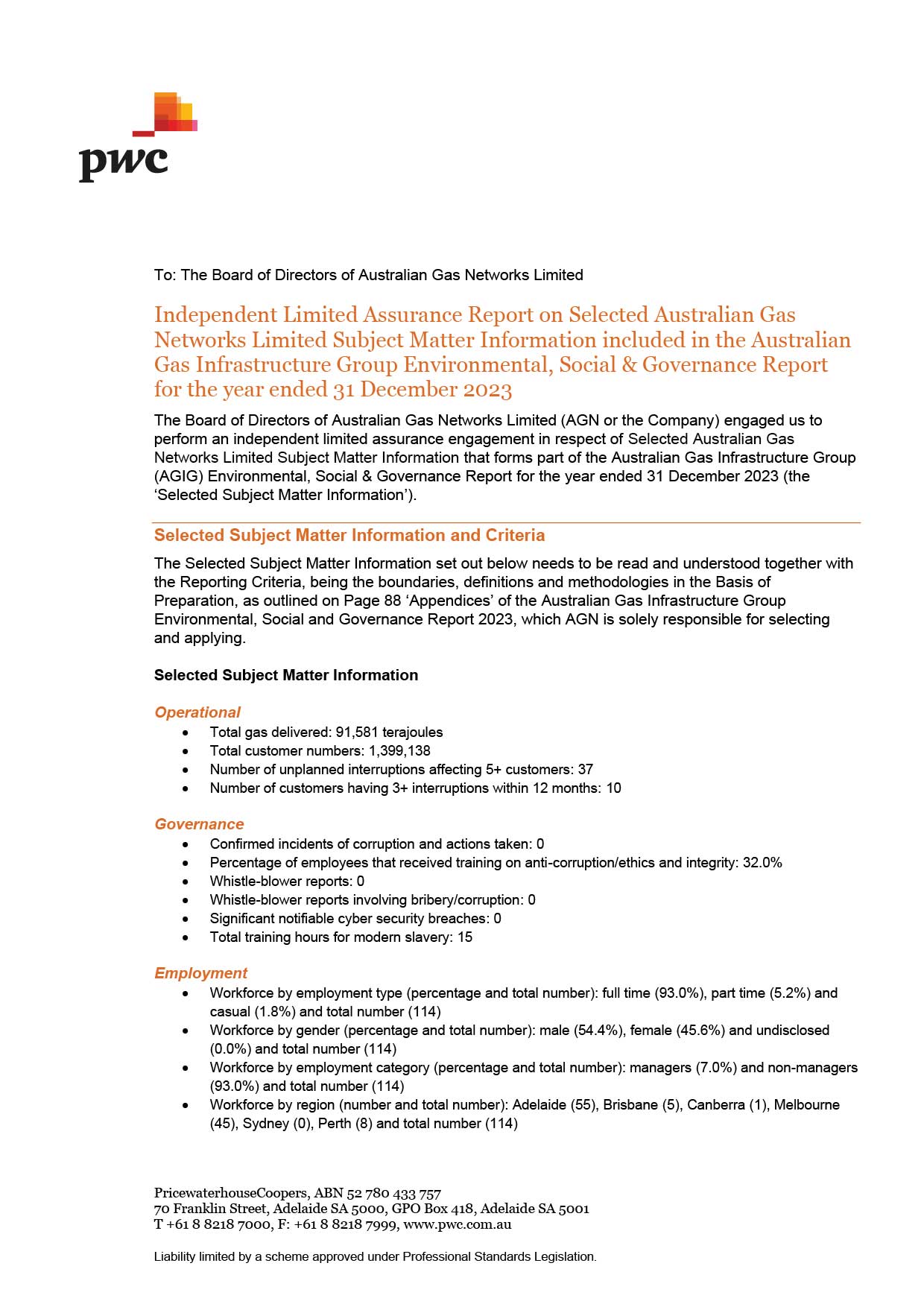 |
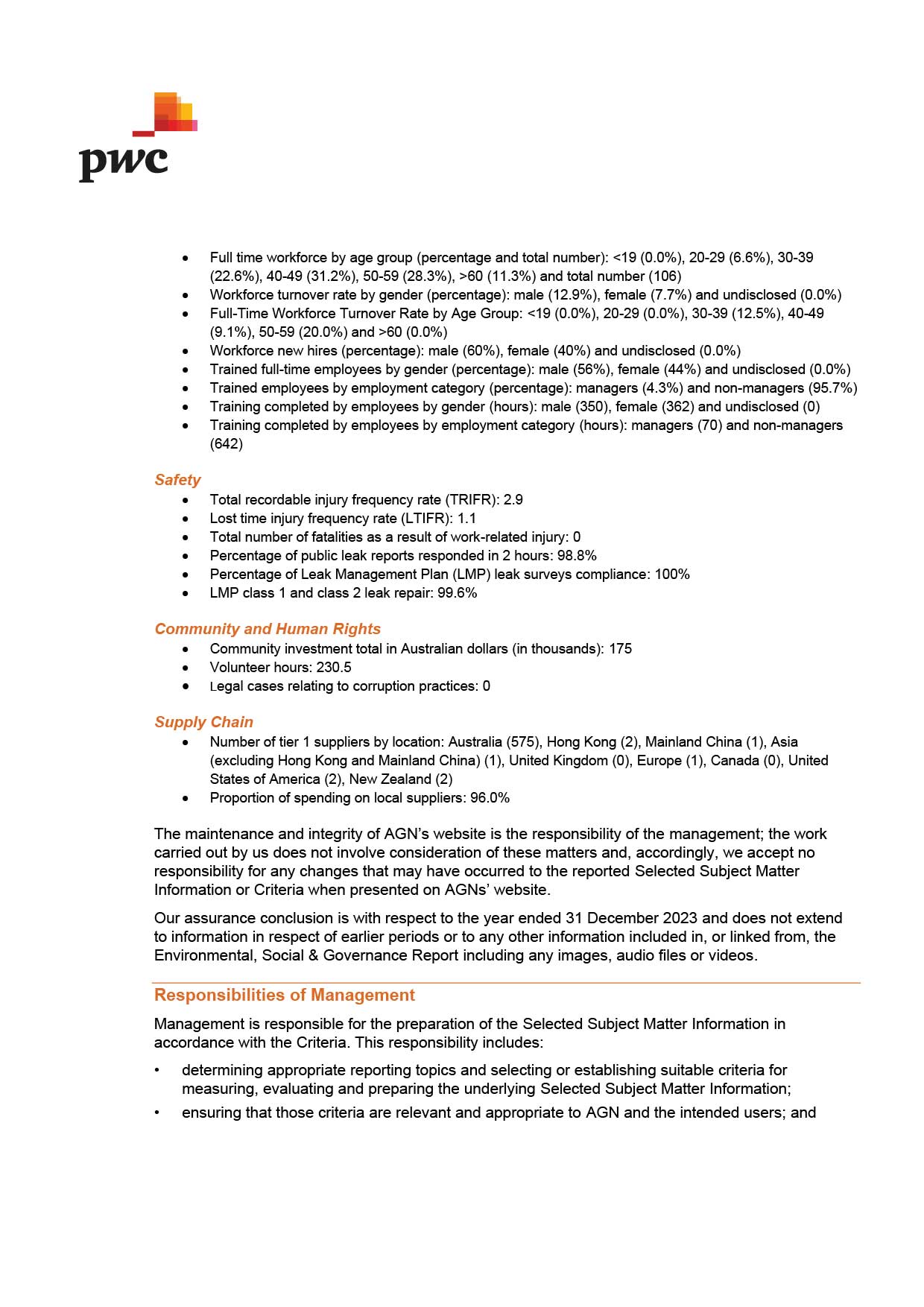 |
 |
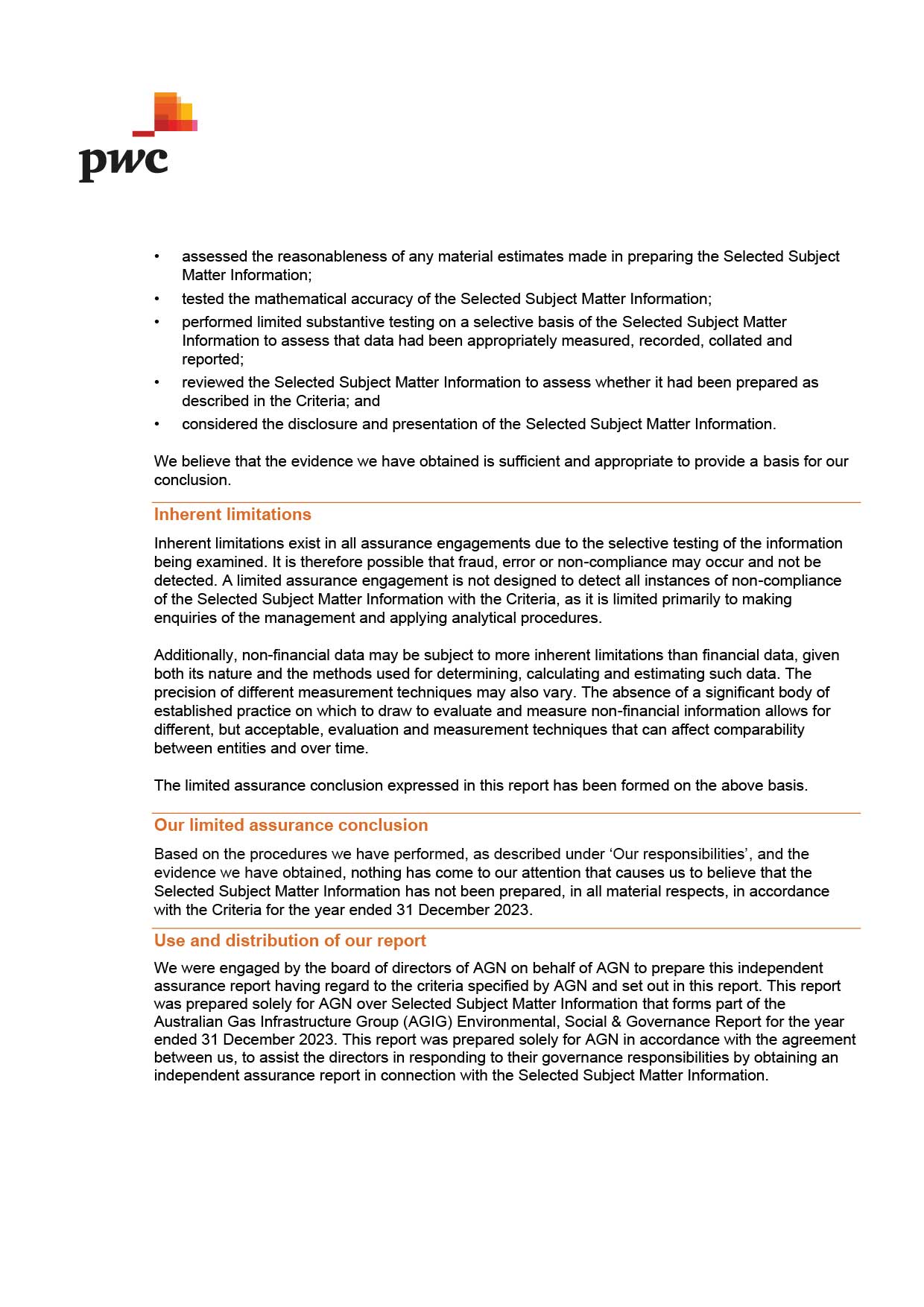 |
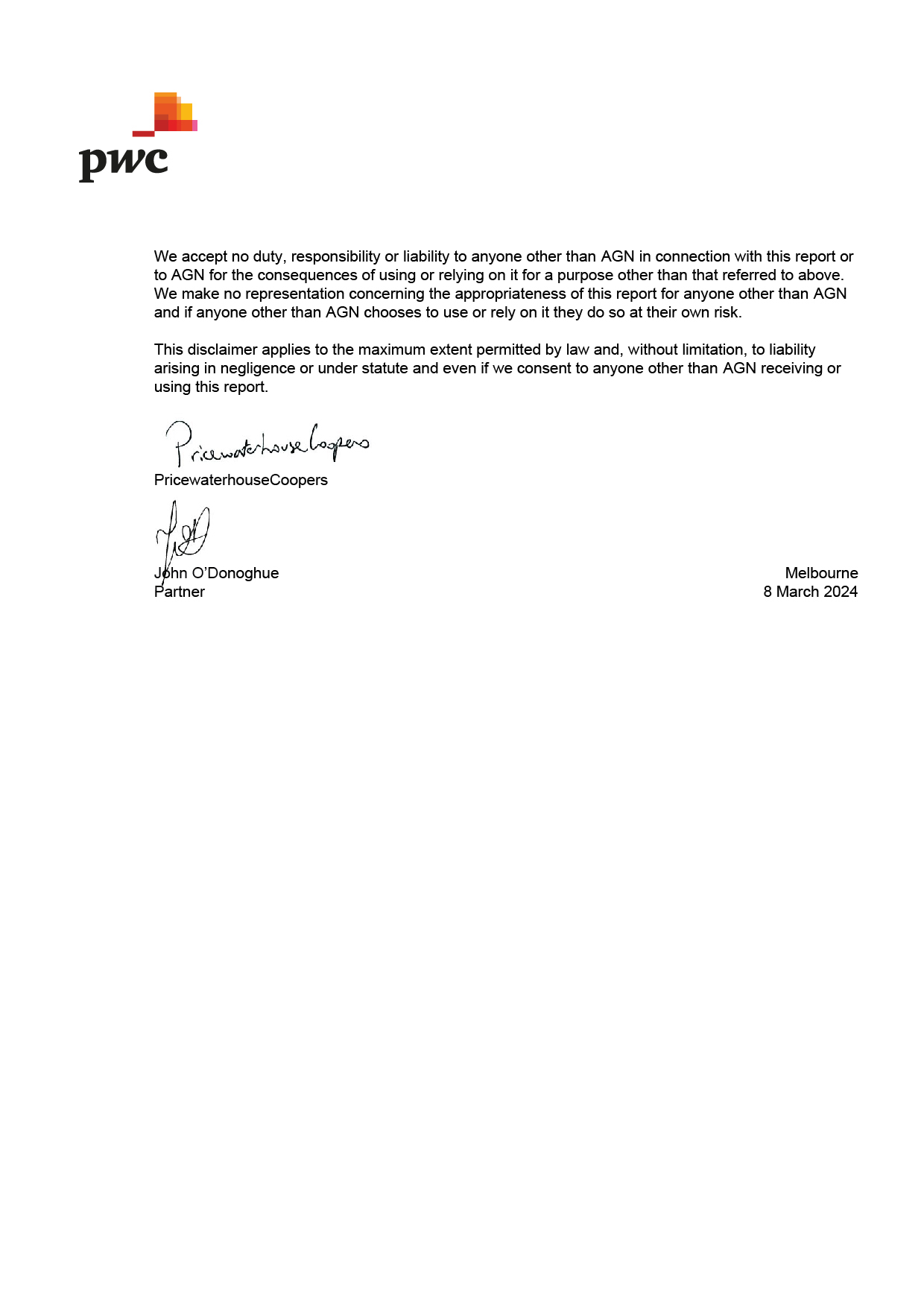 |
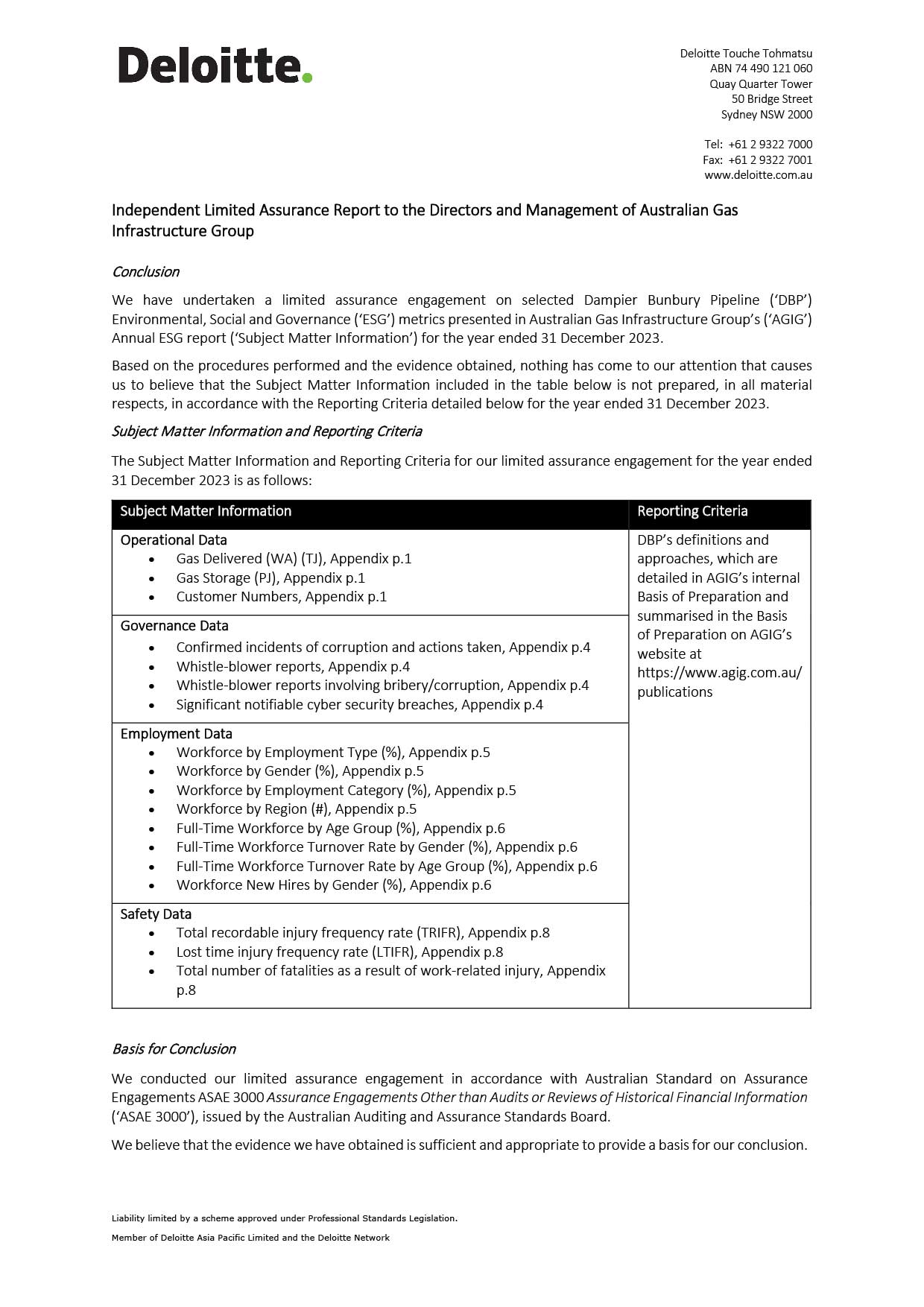 |
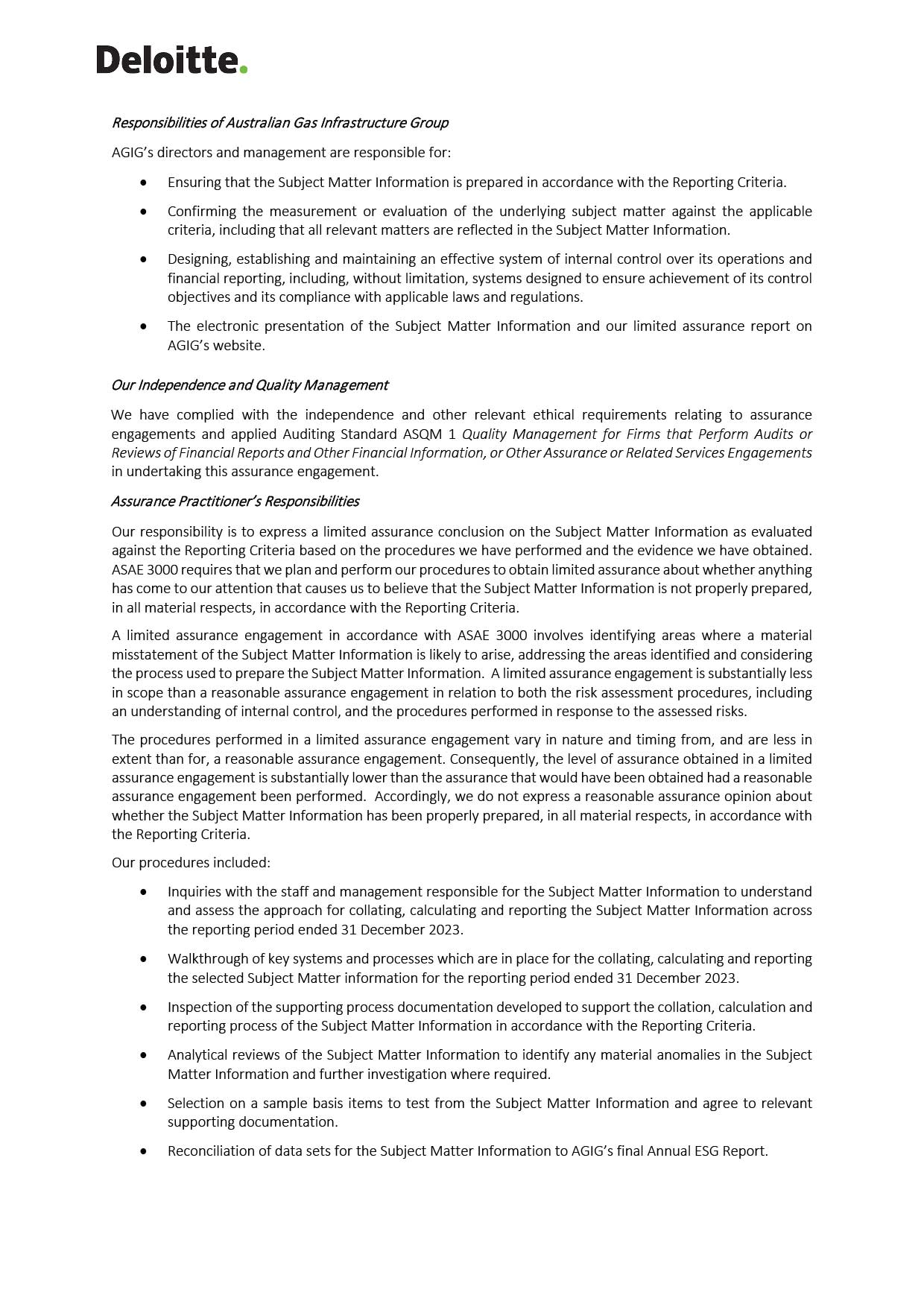 |
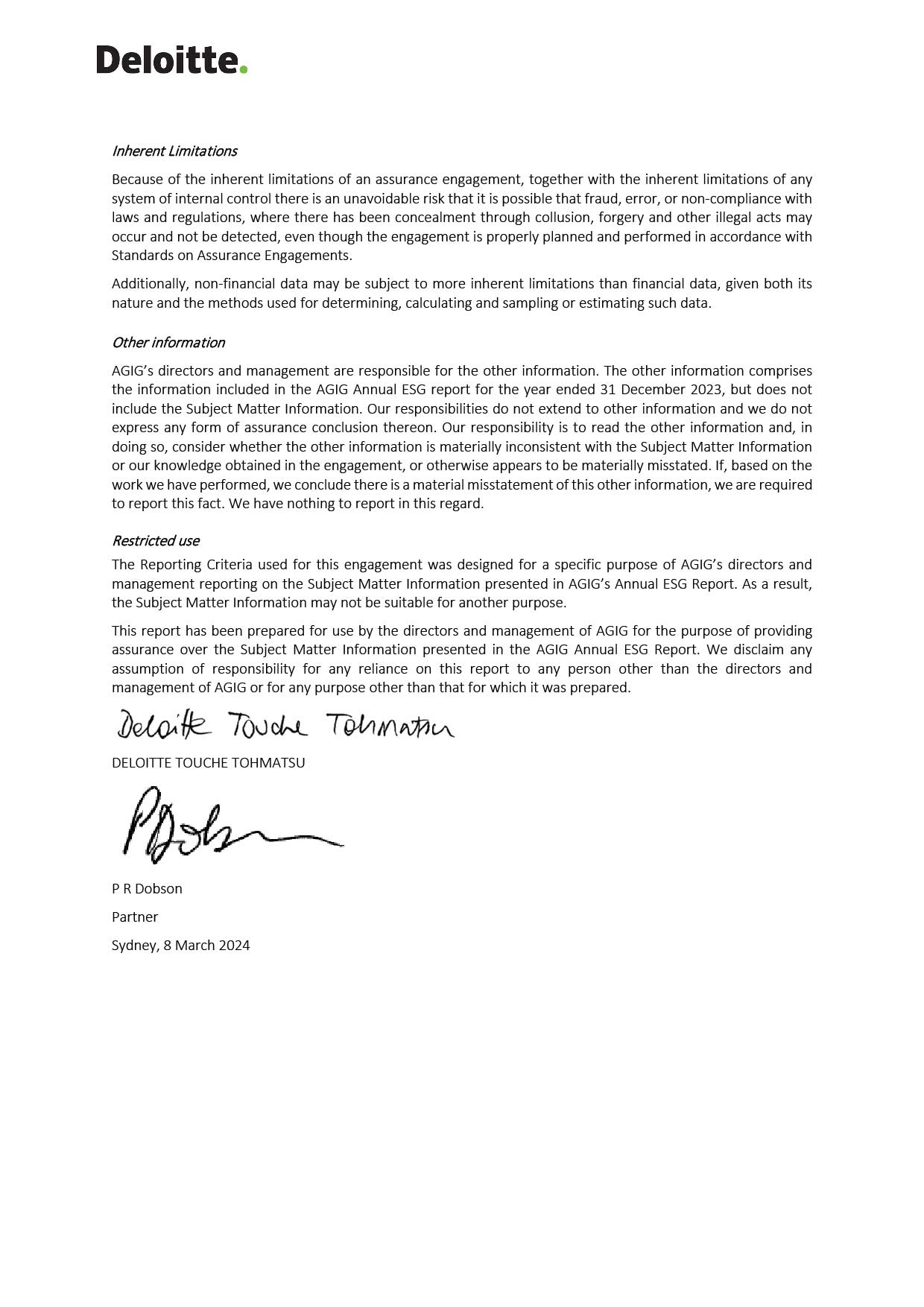 |
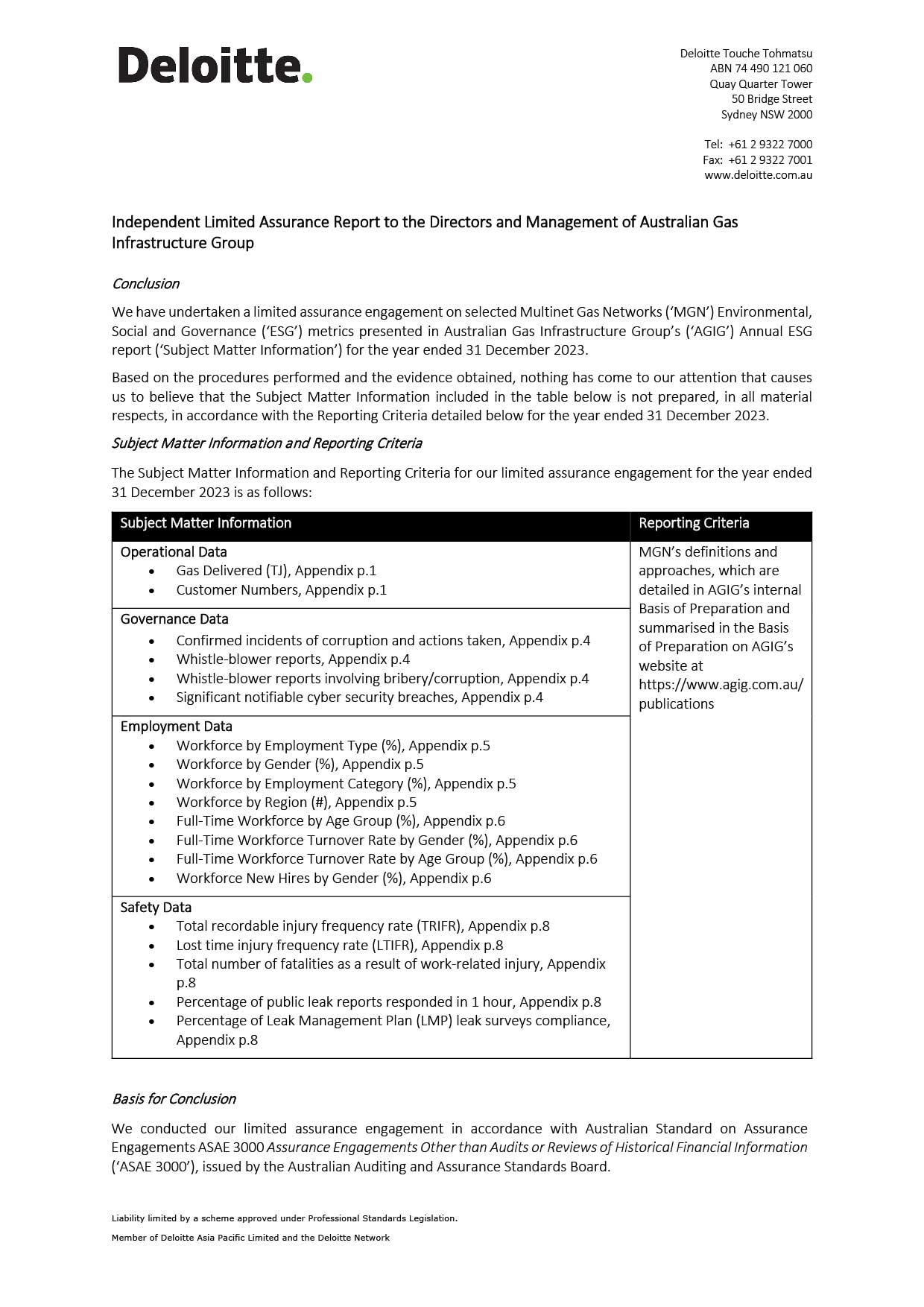 |
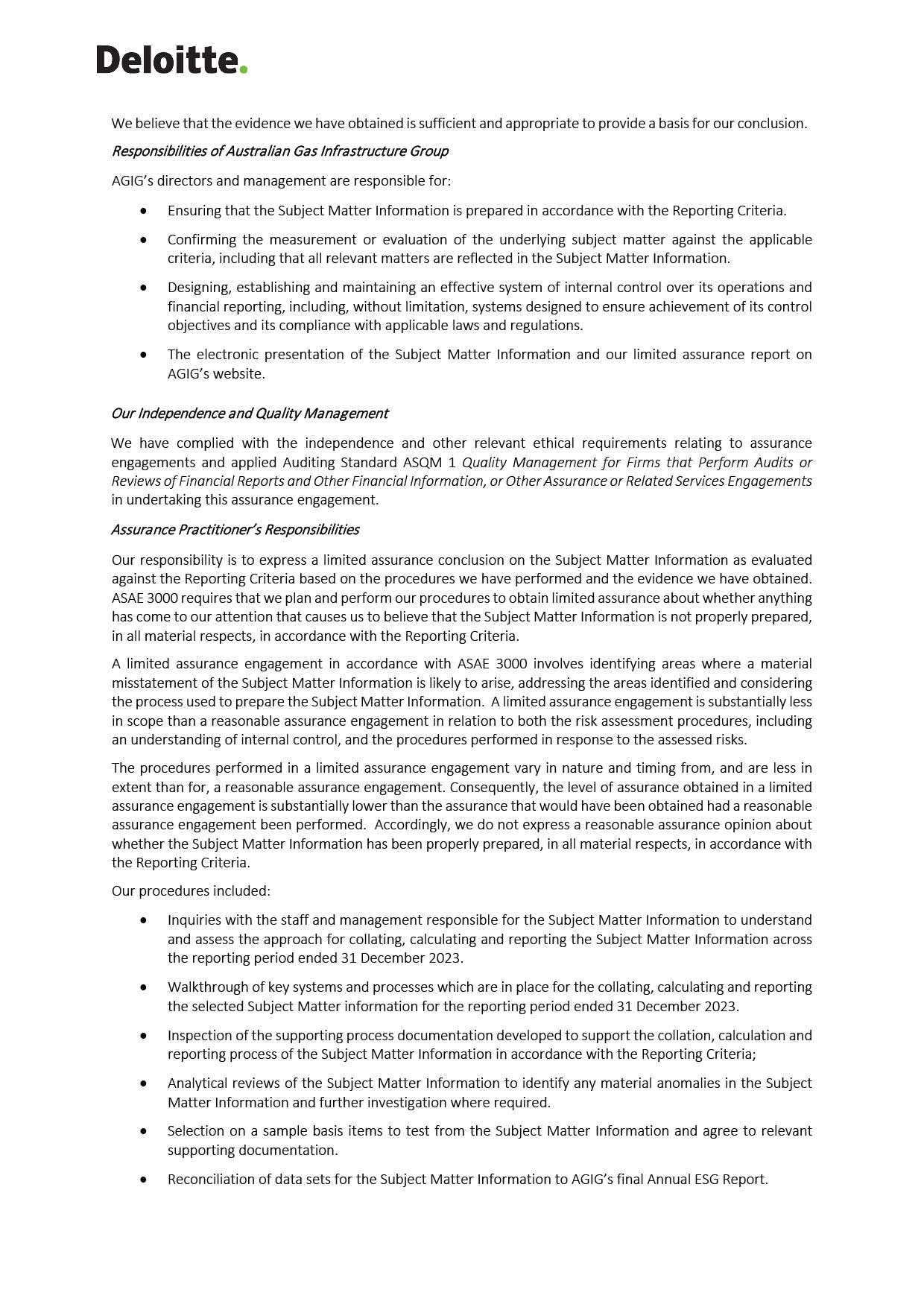 |
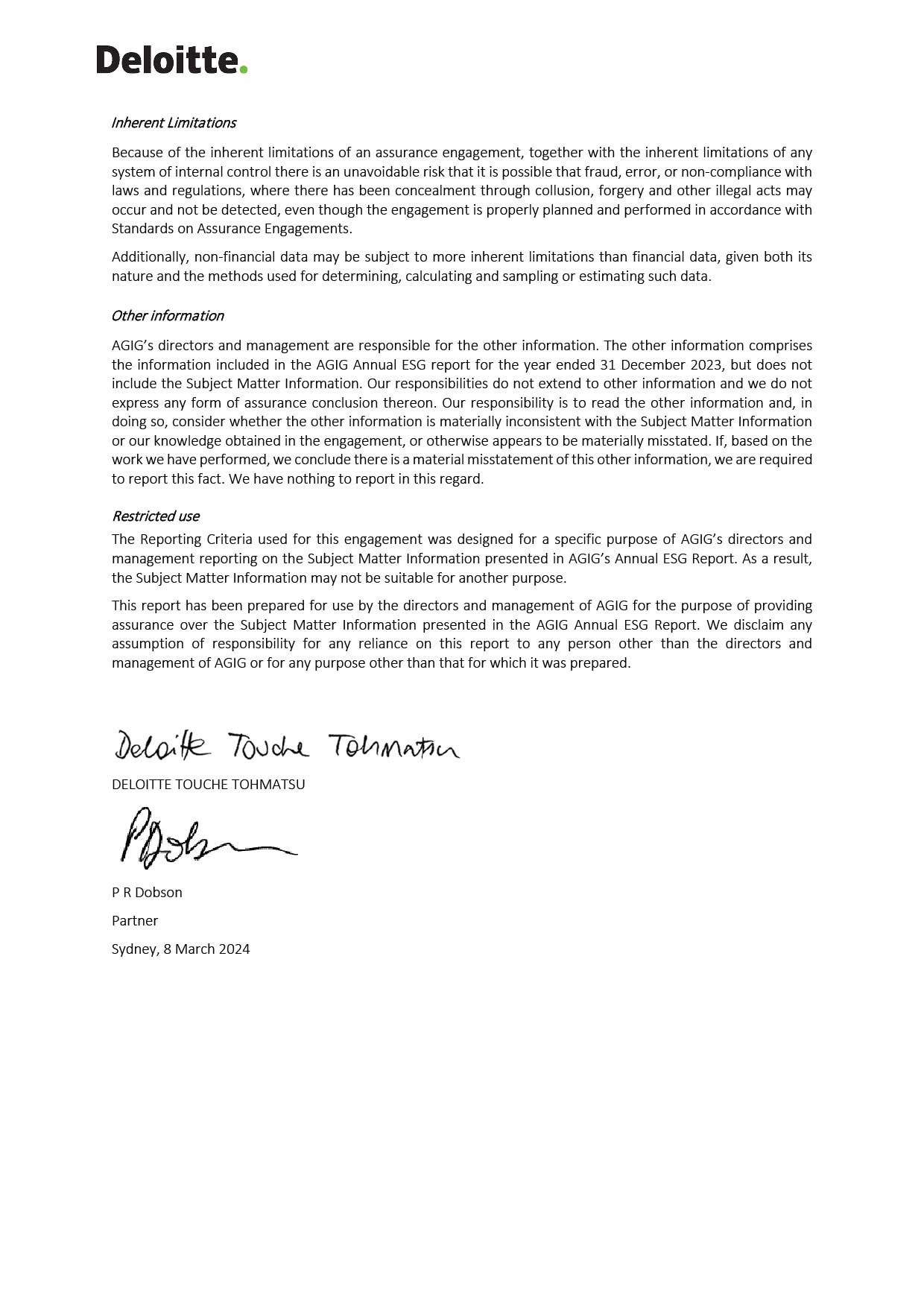 |


